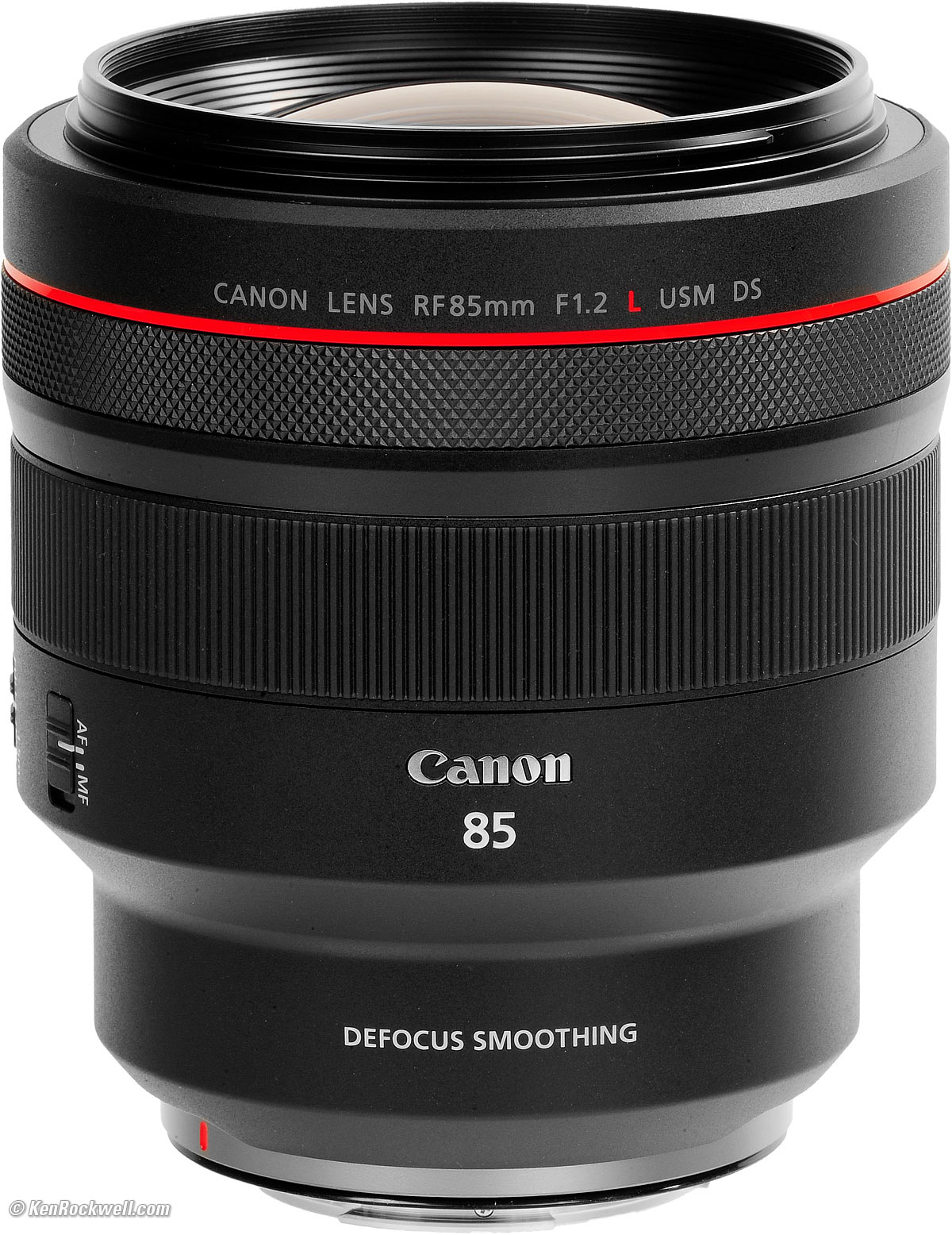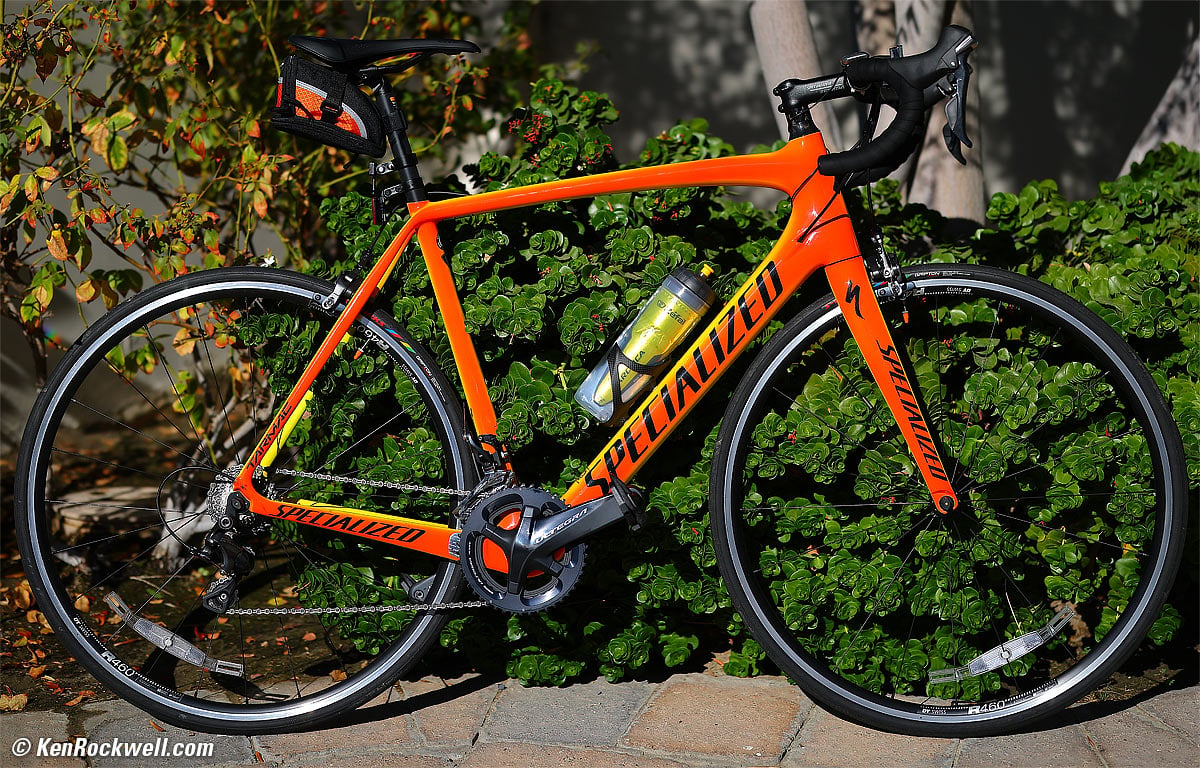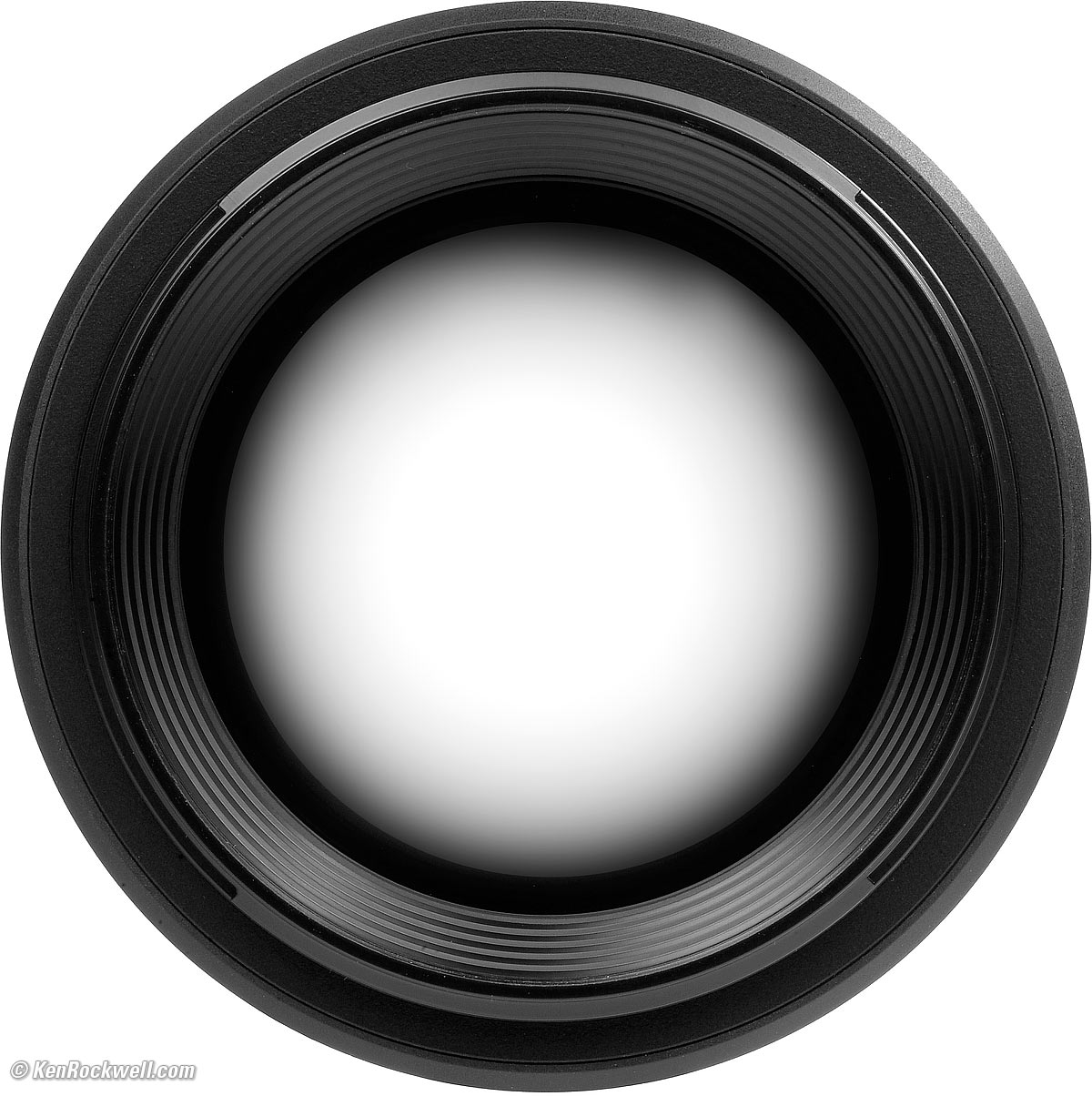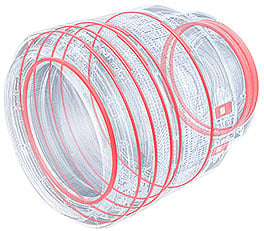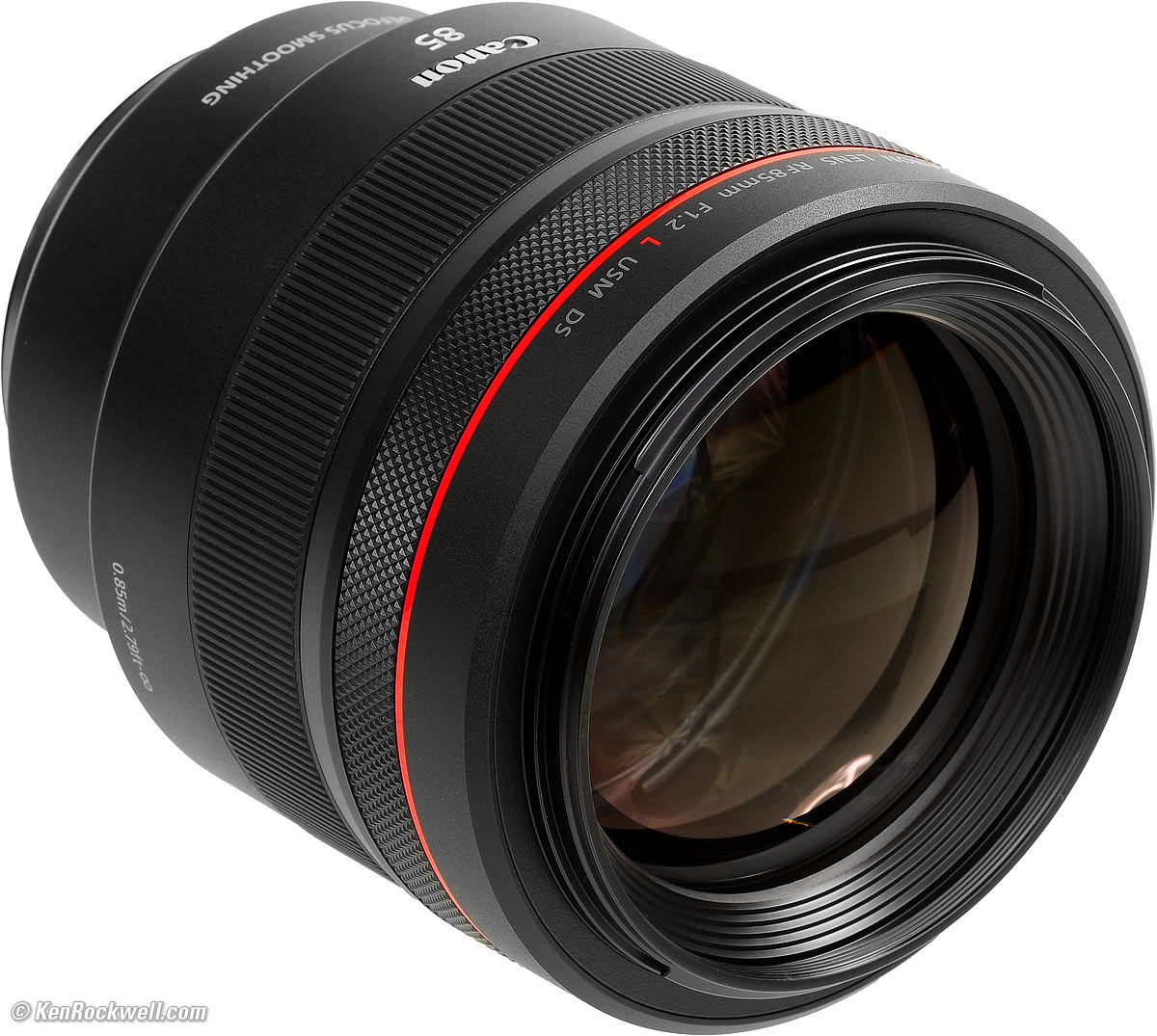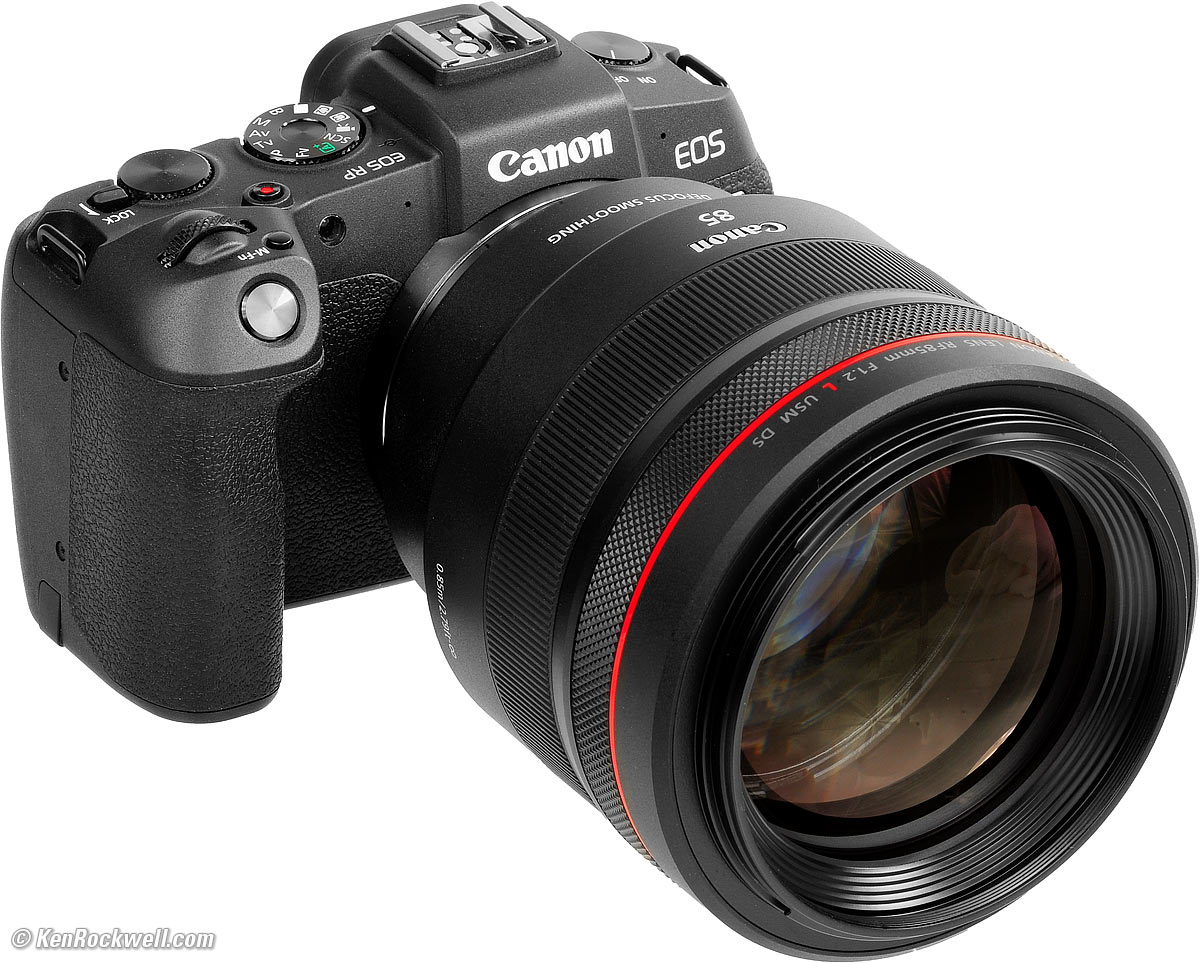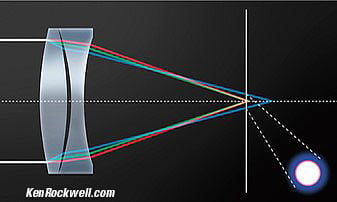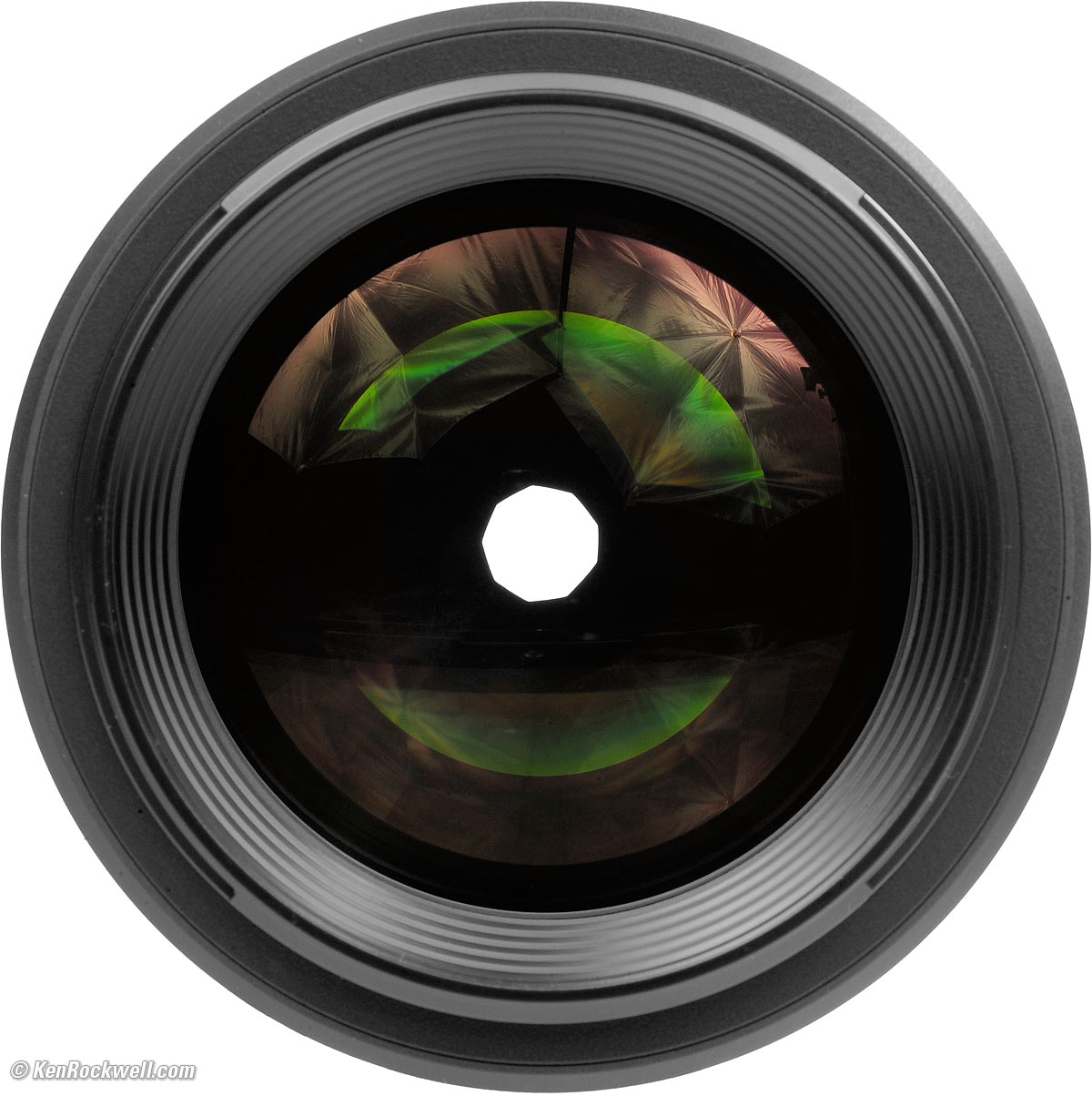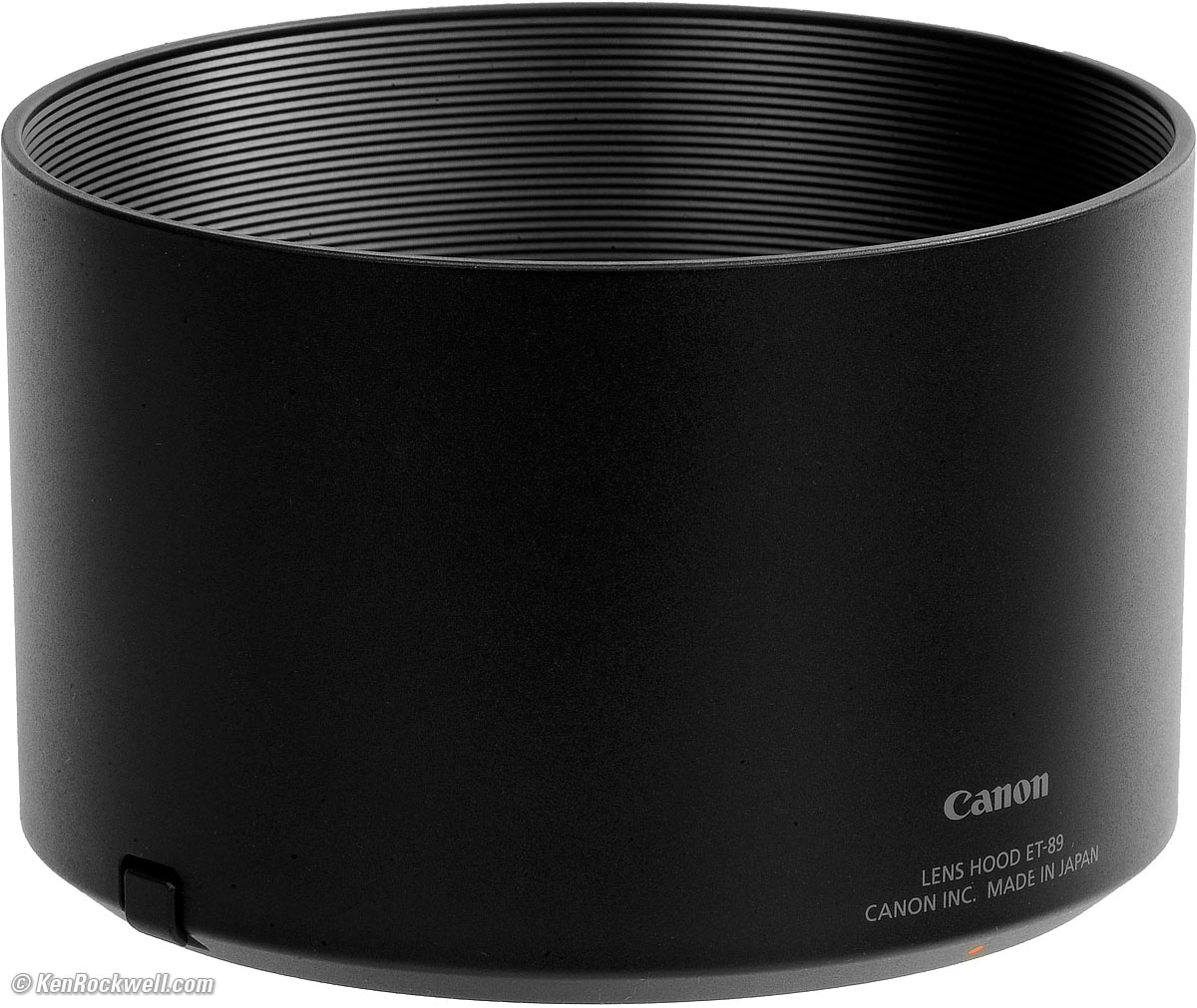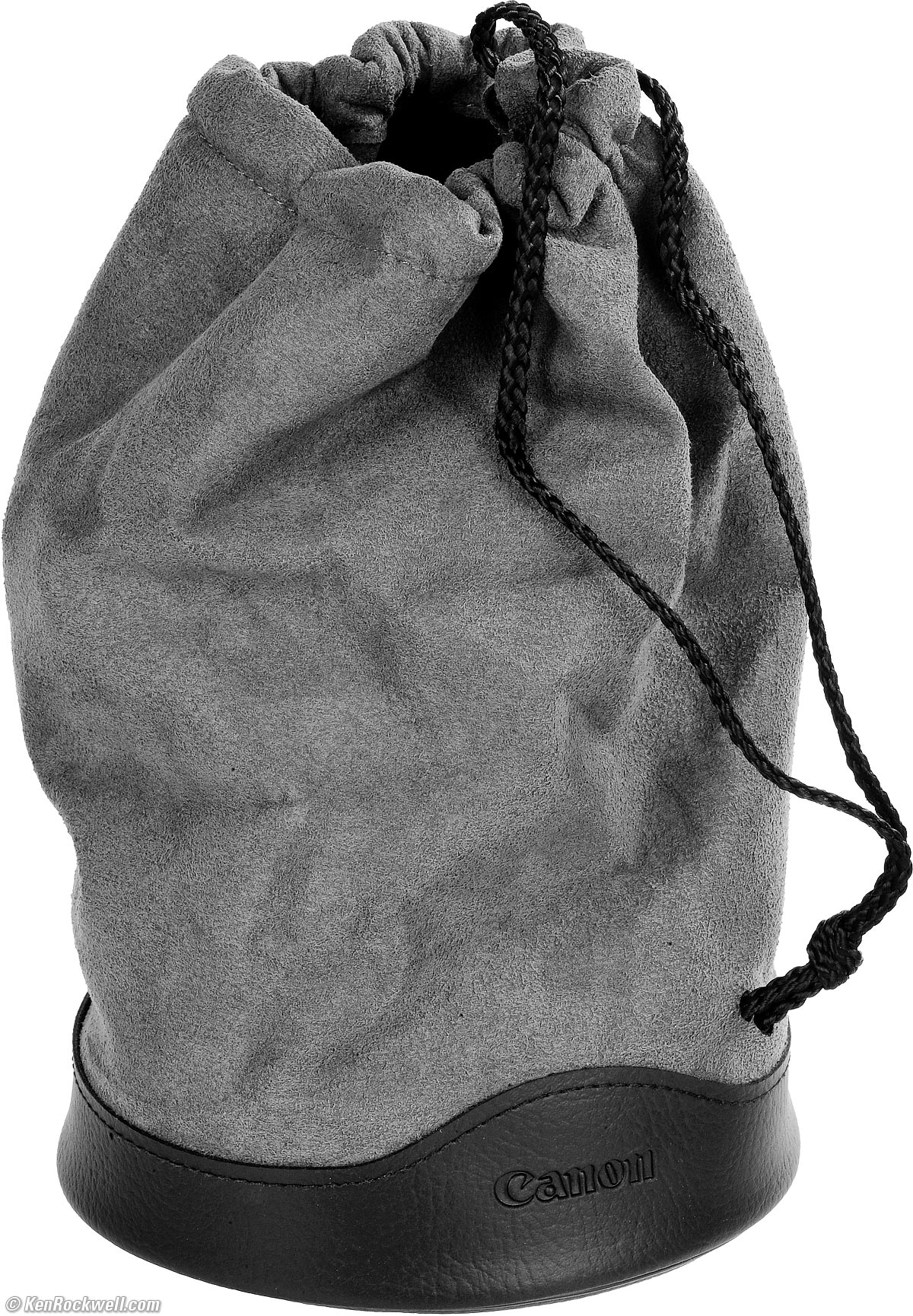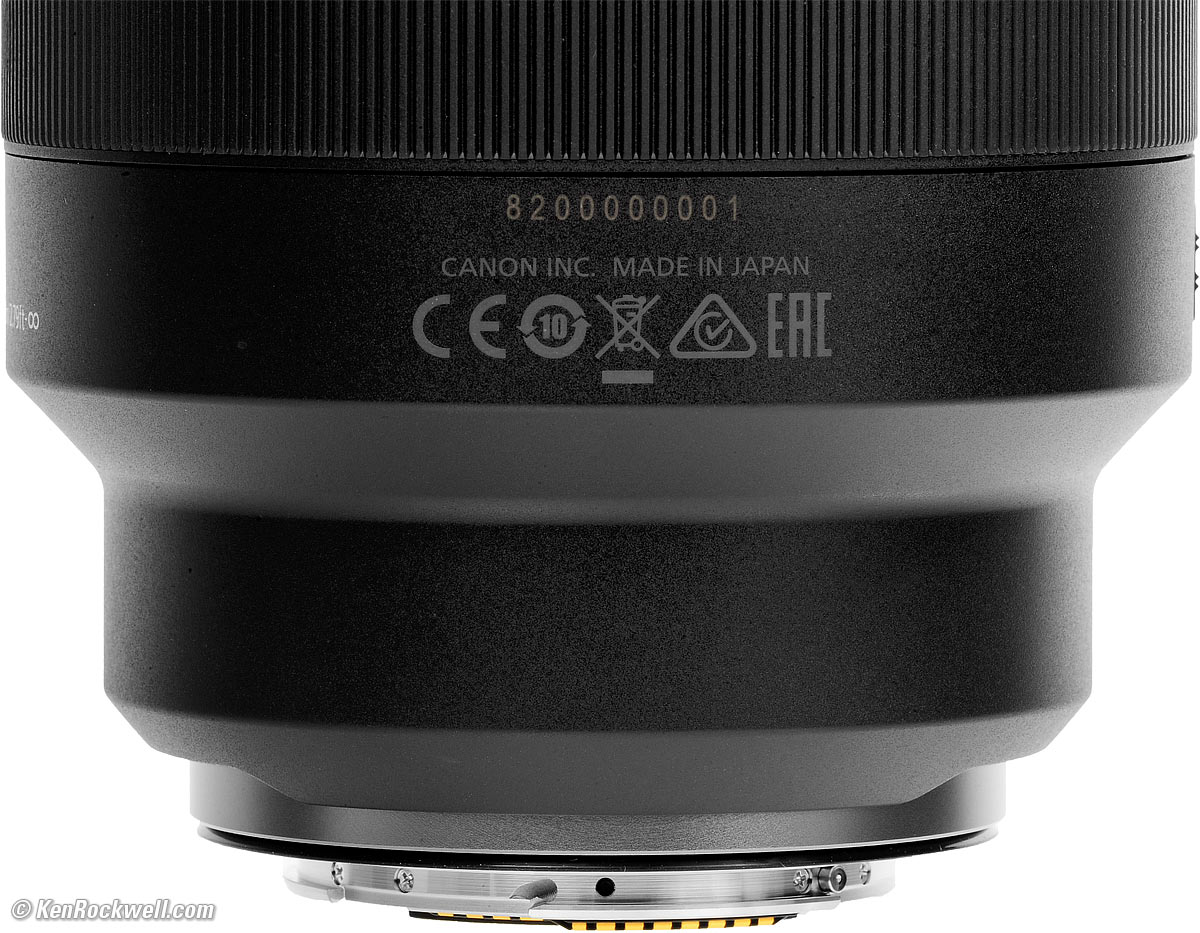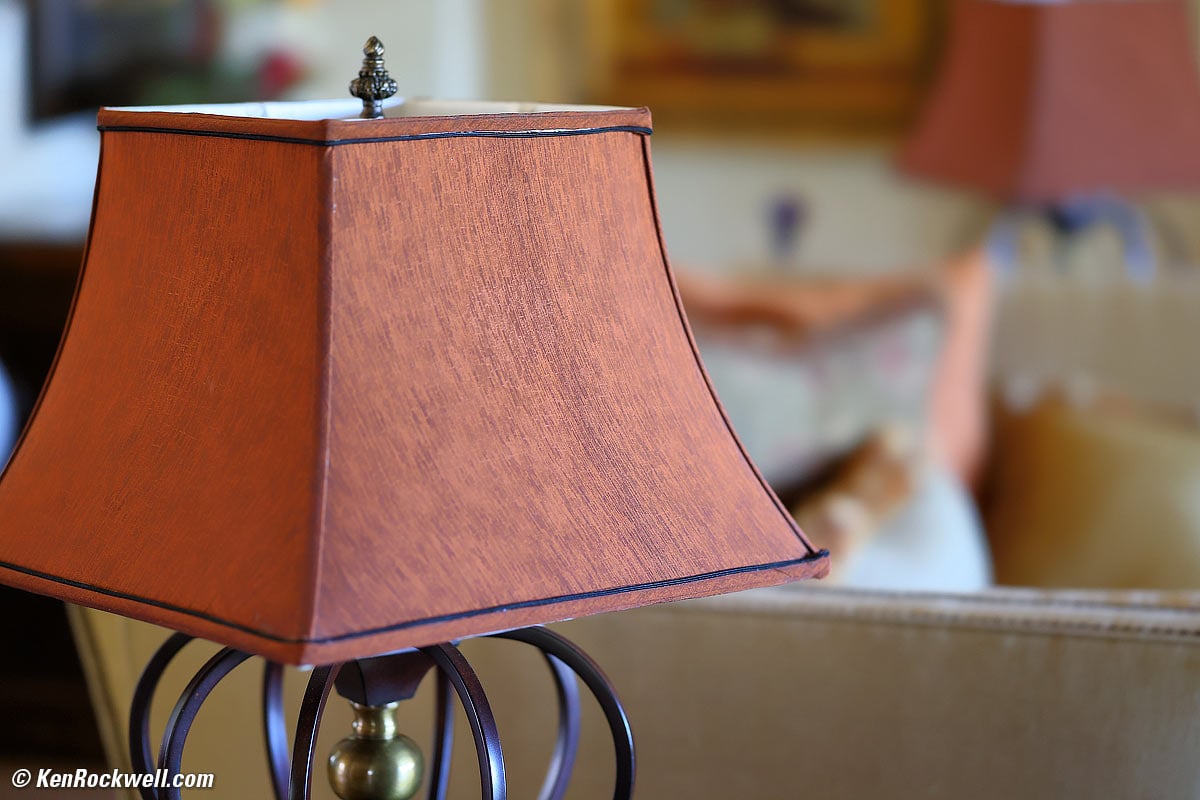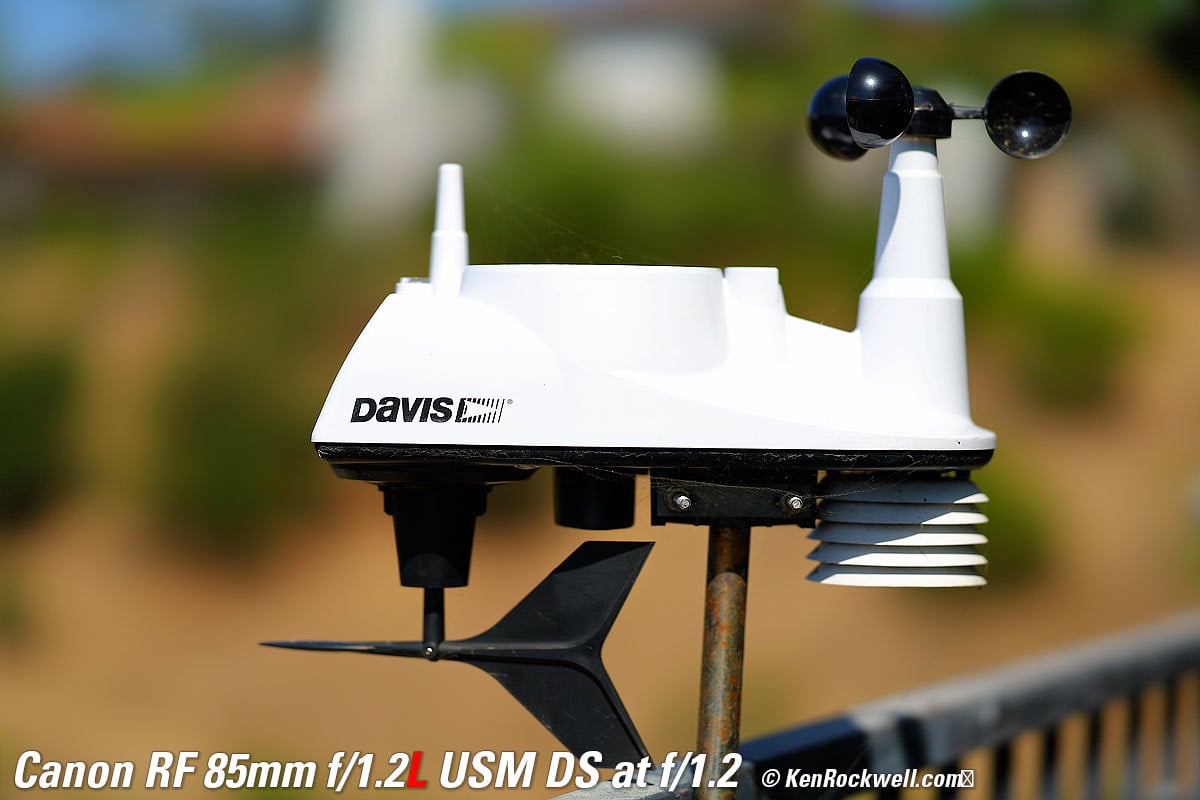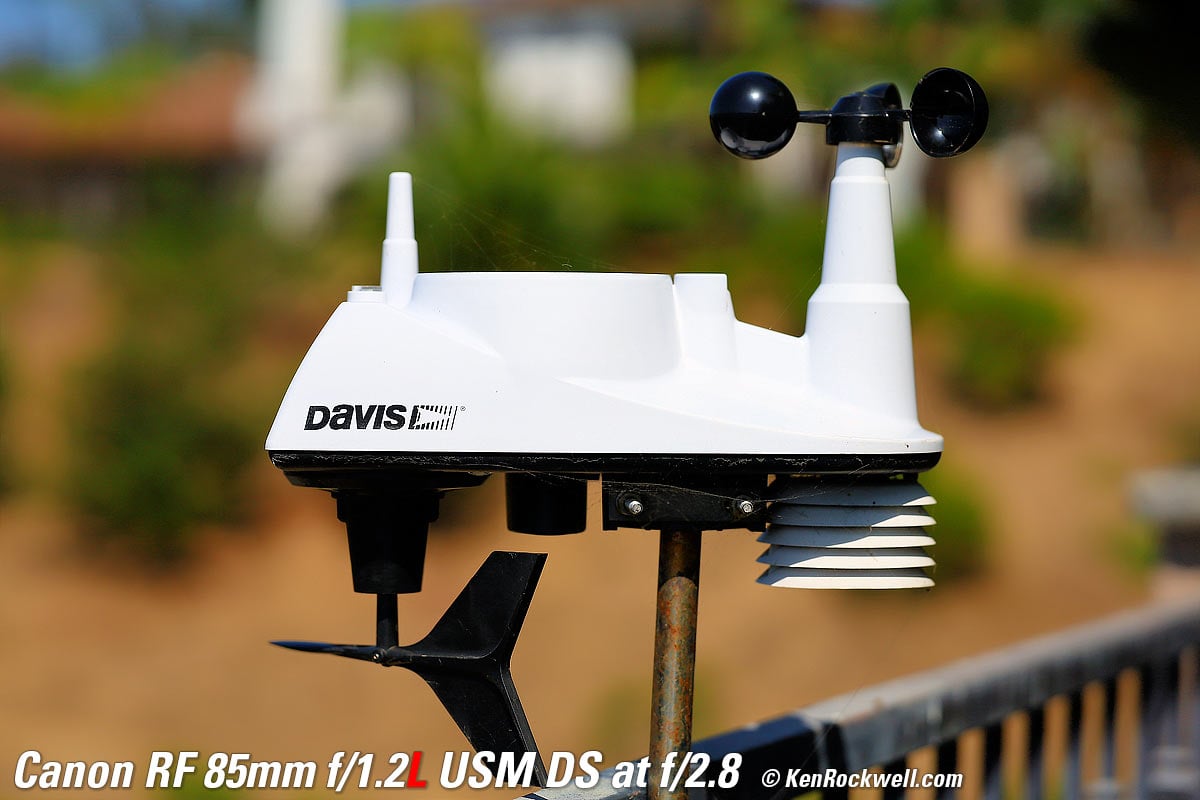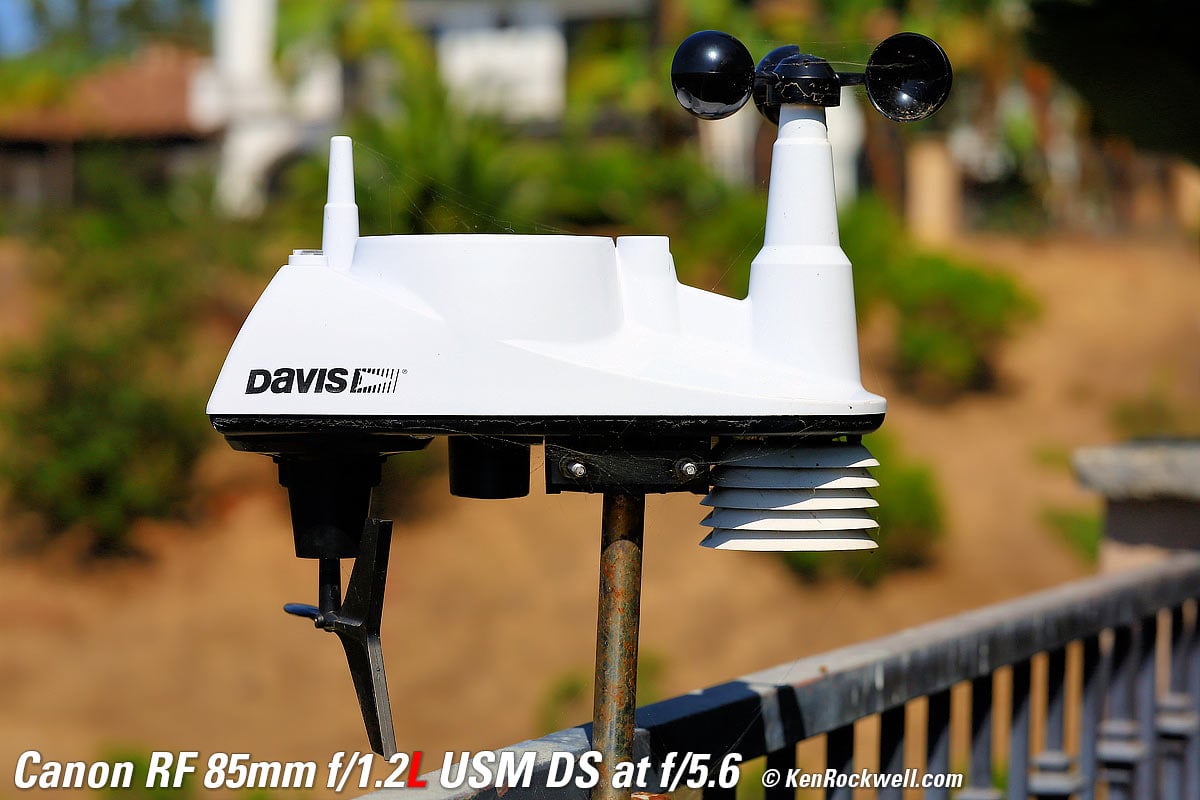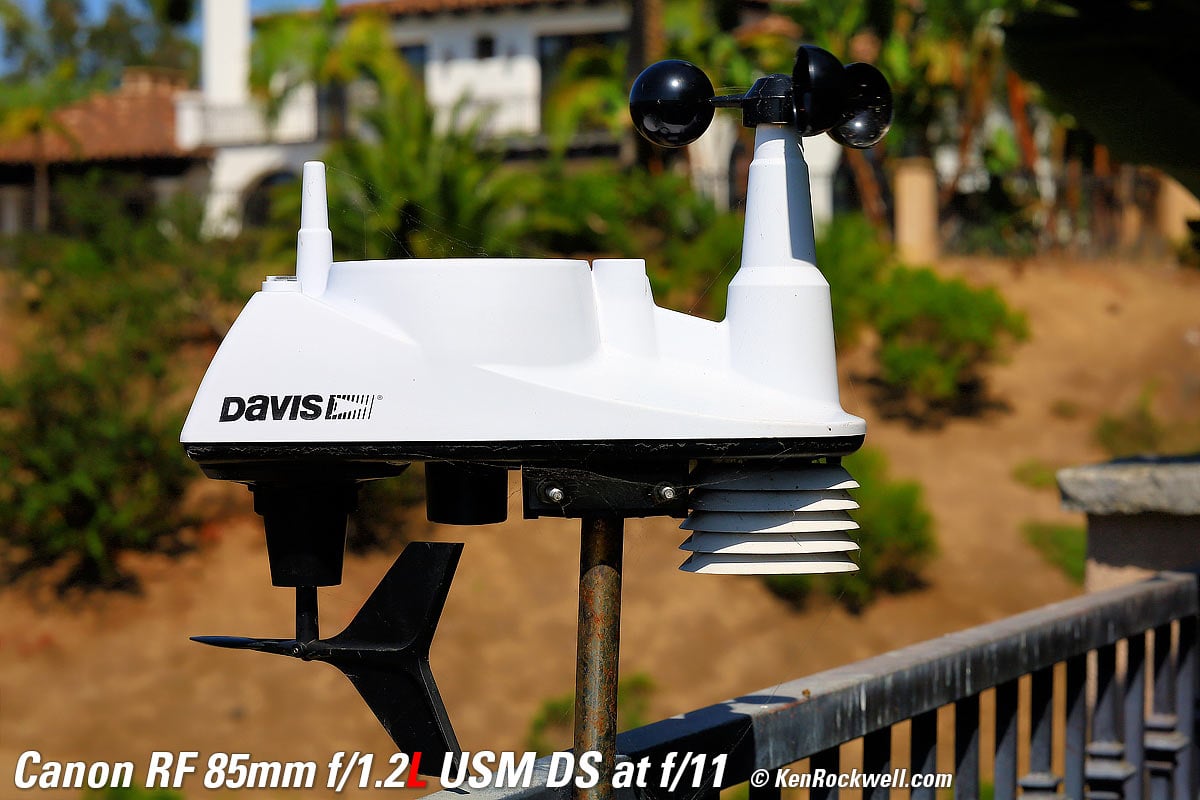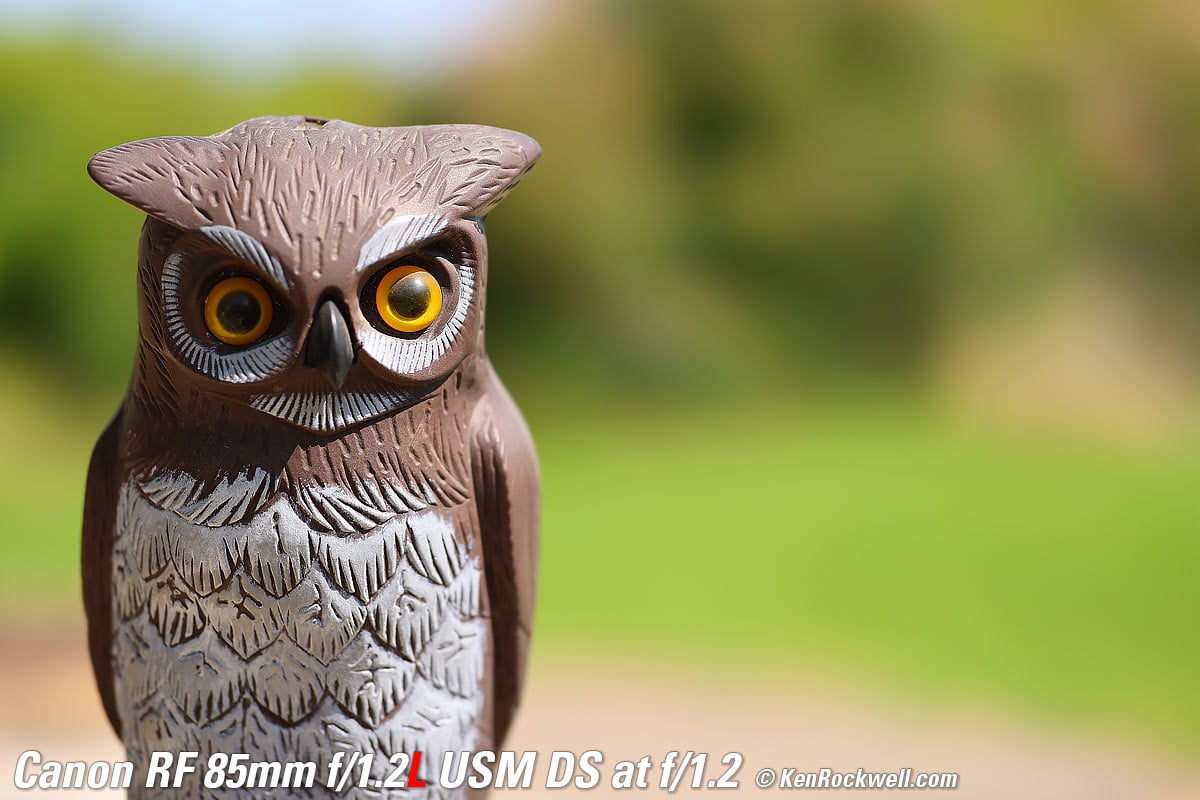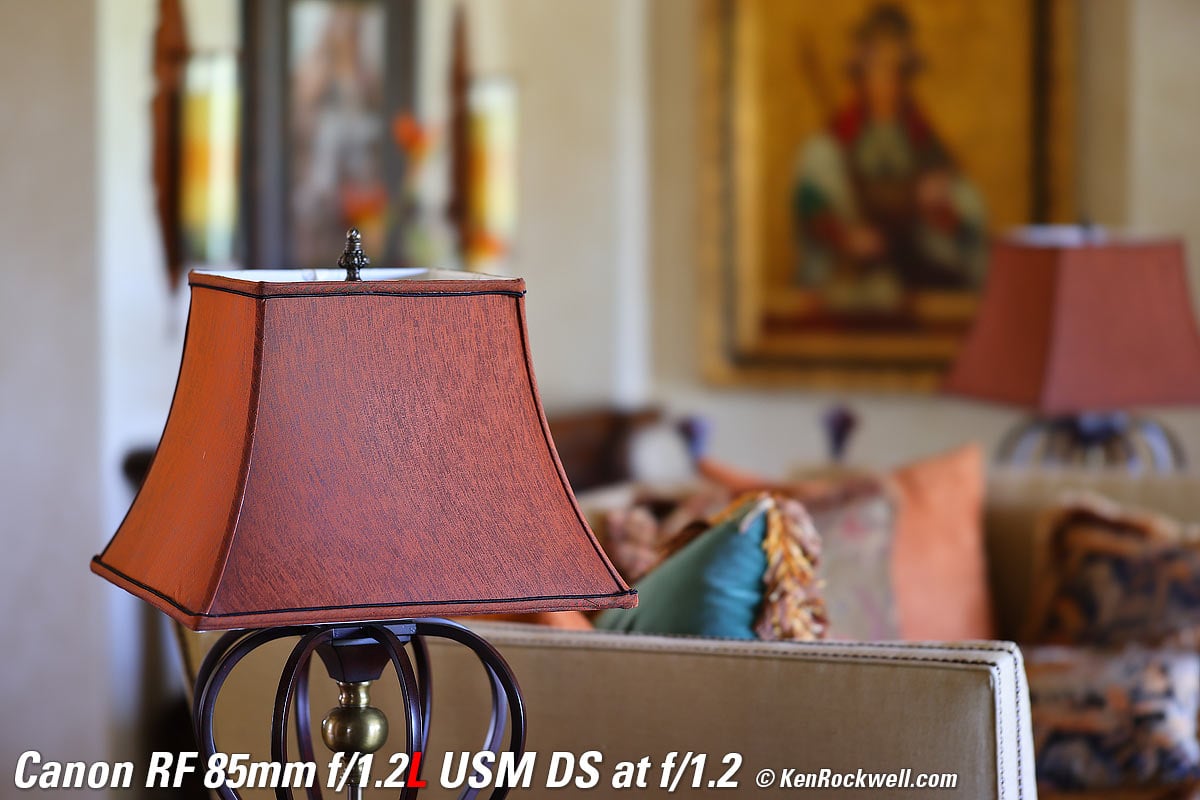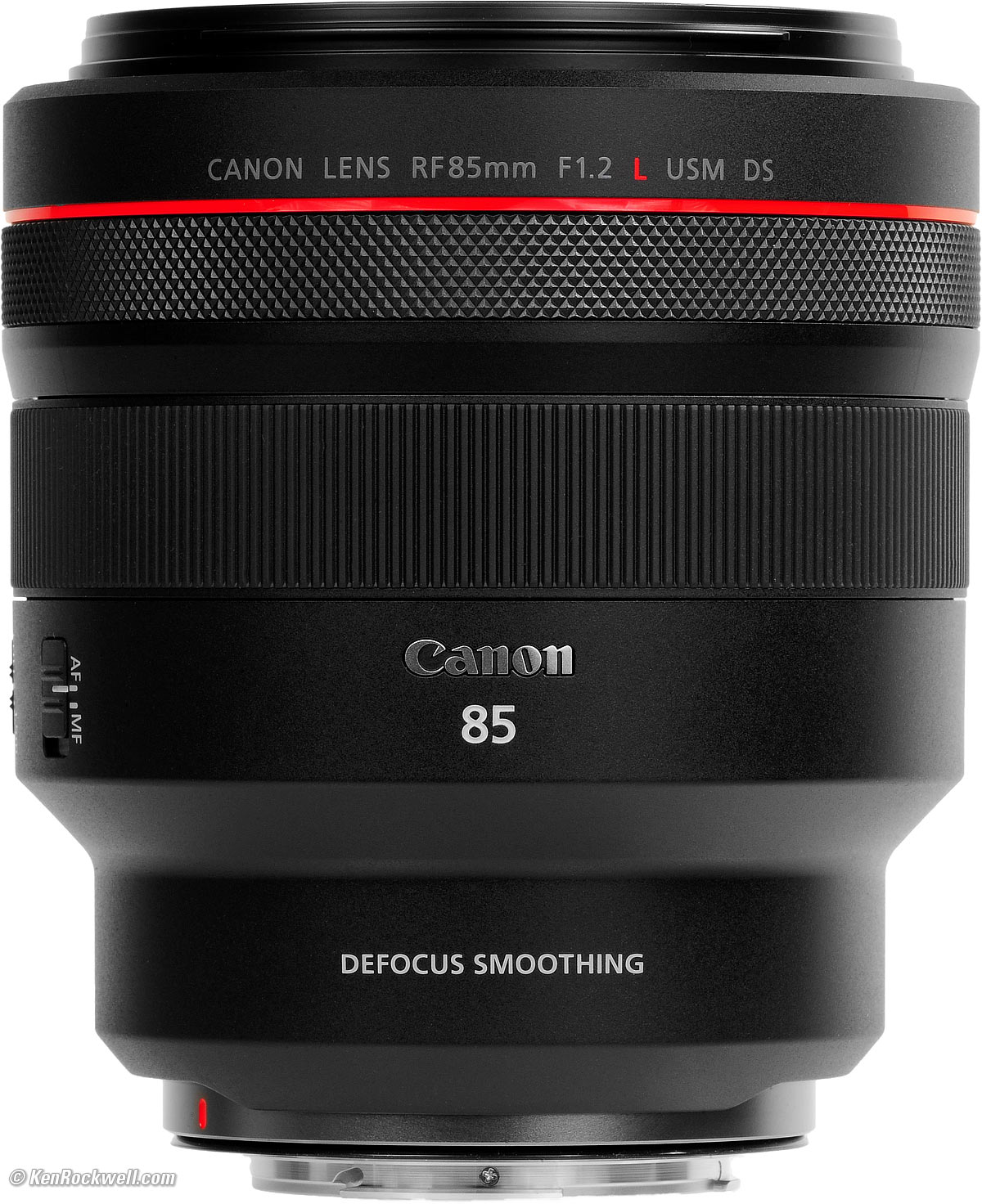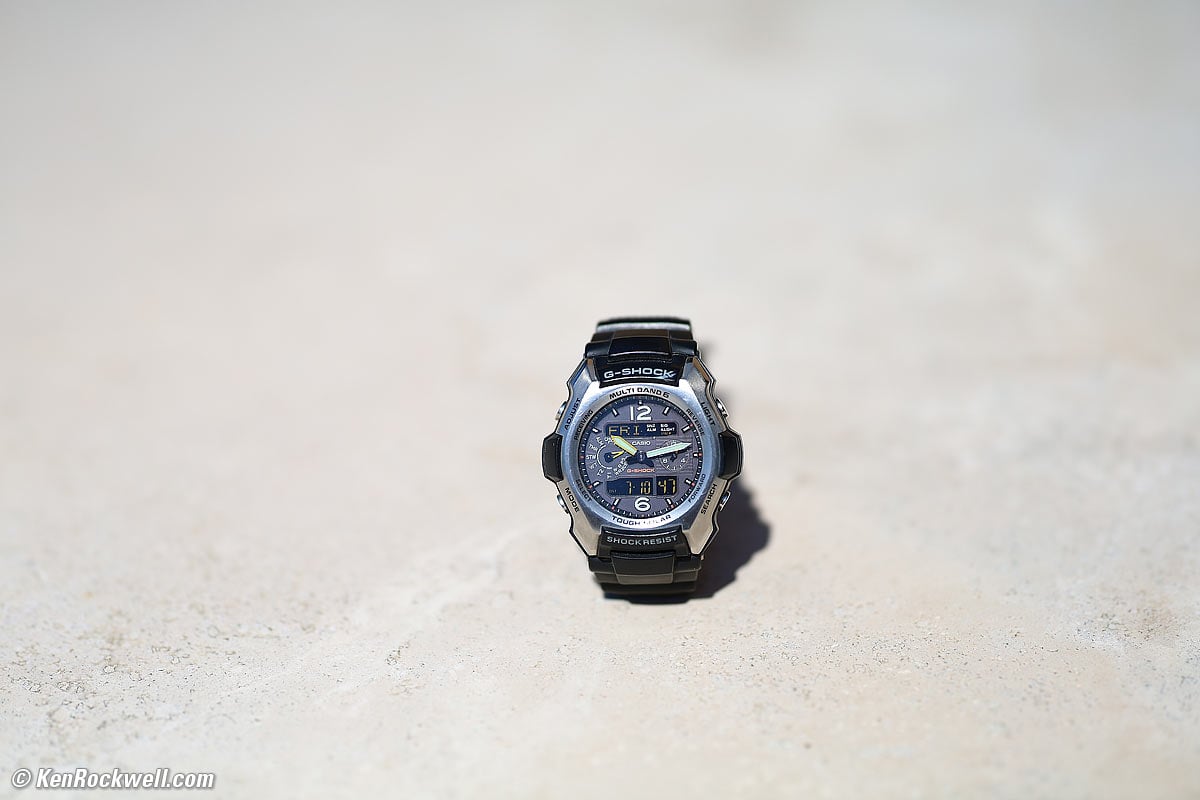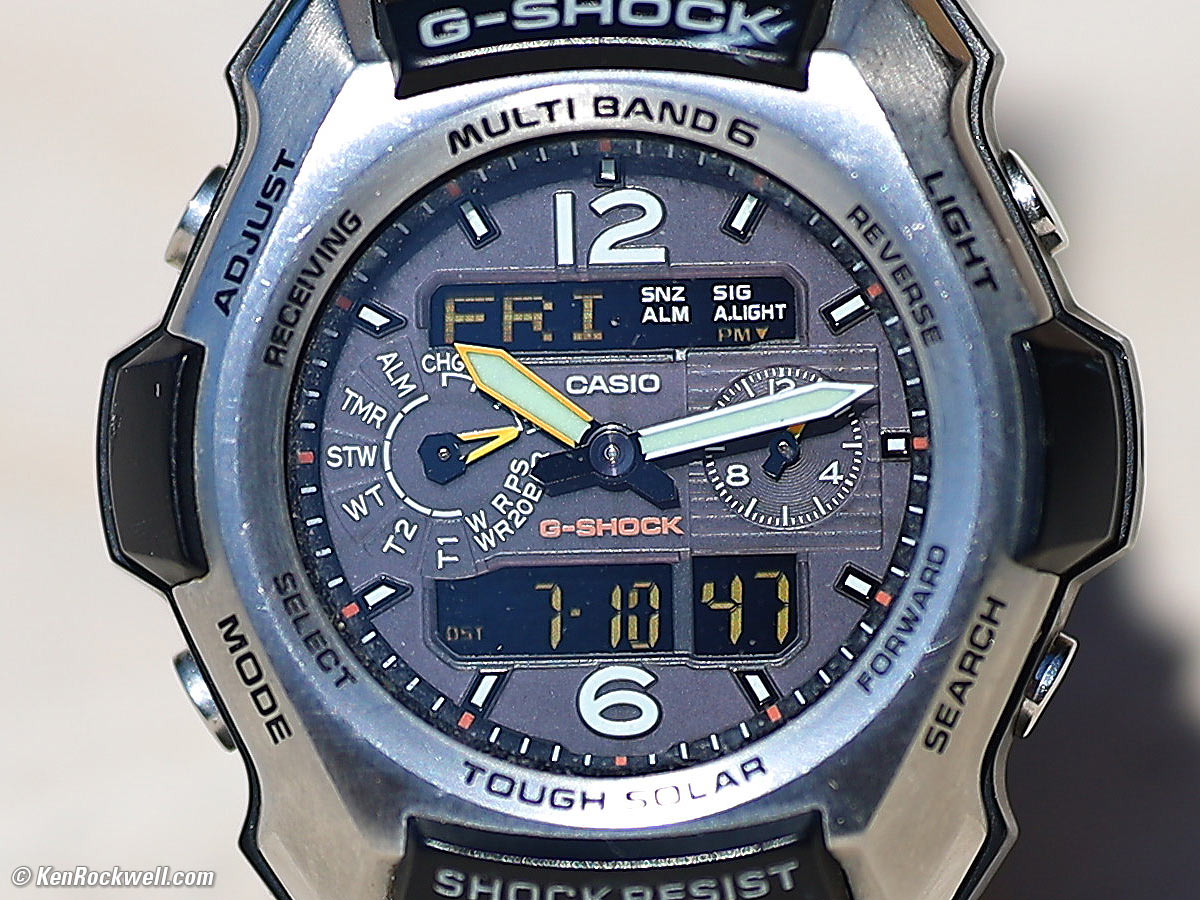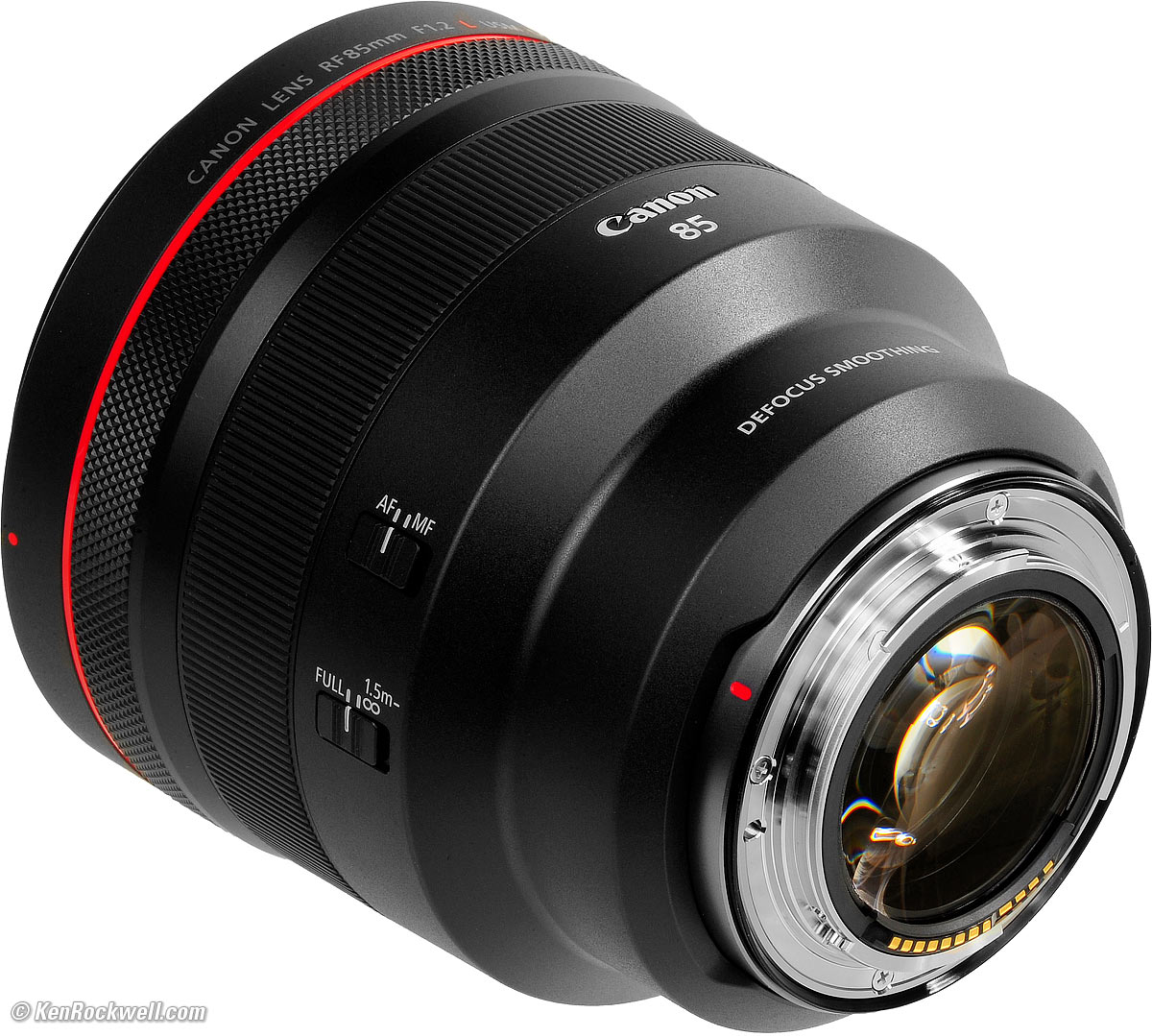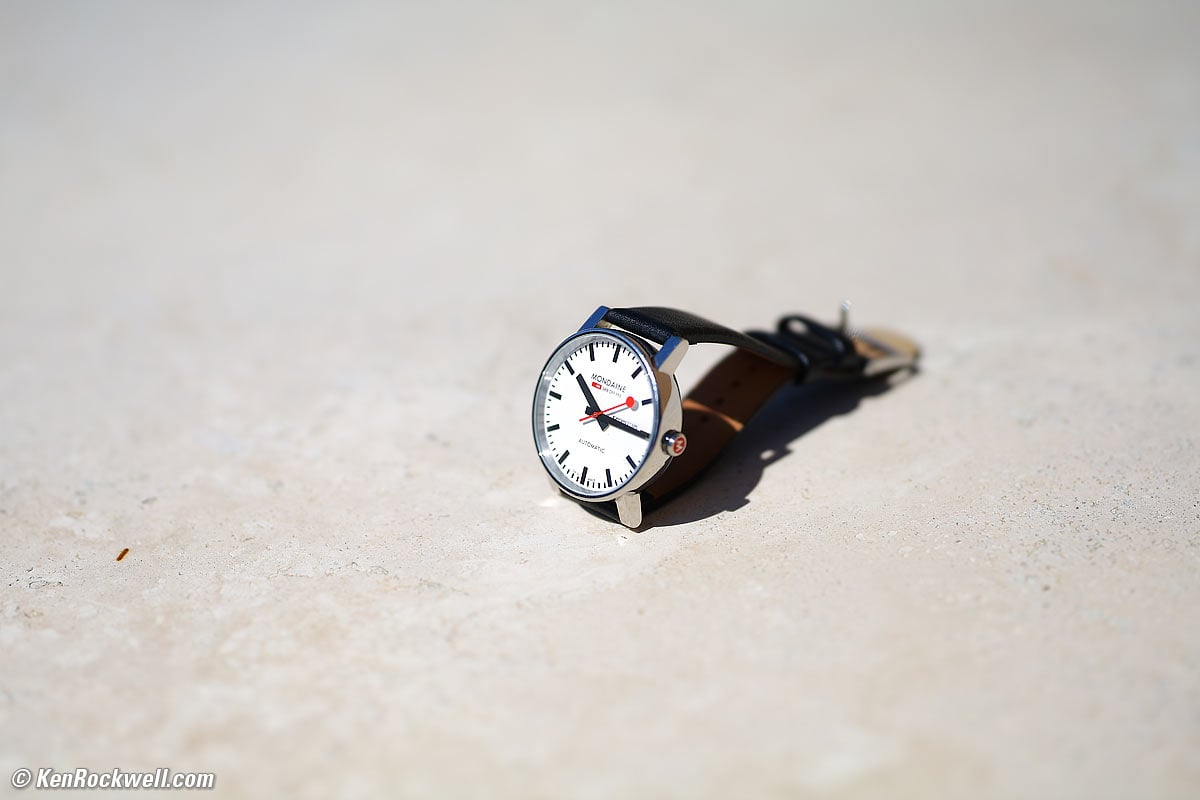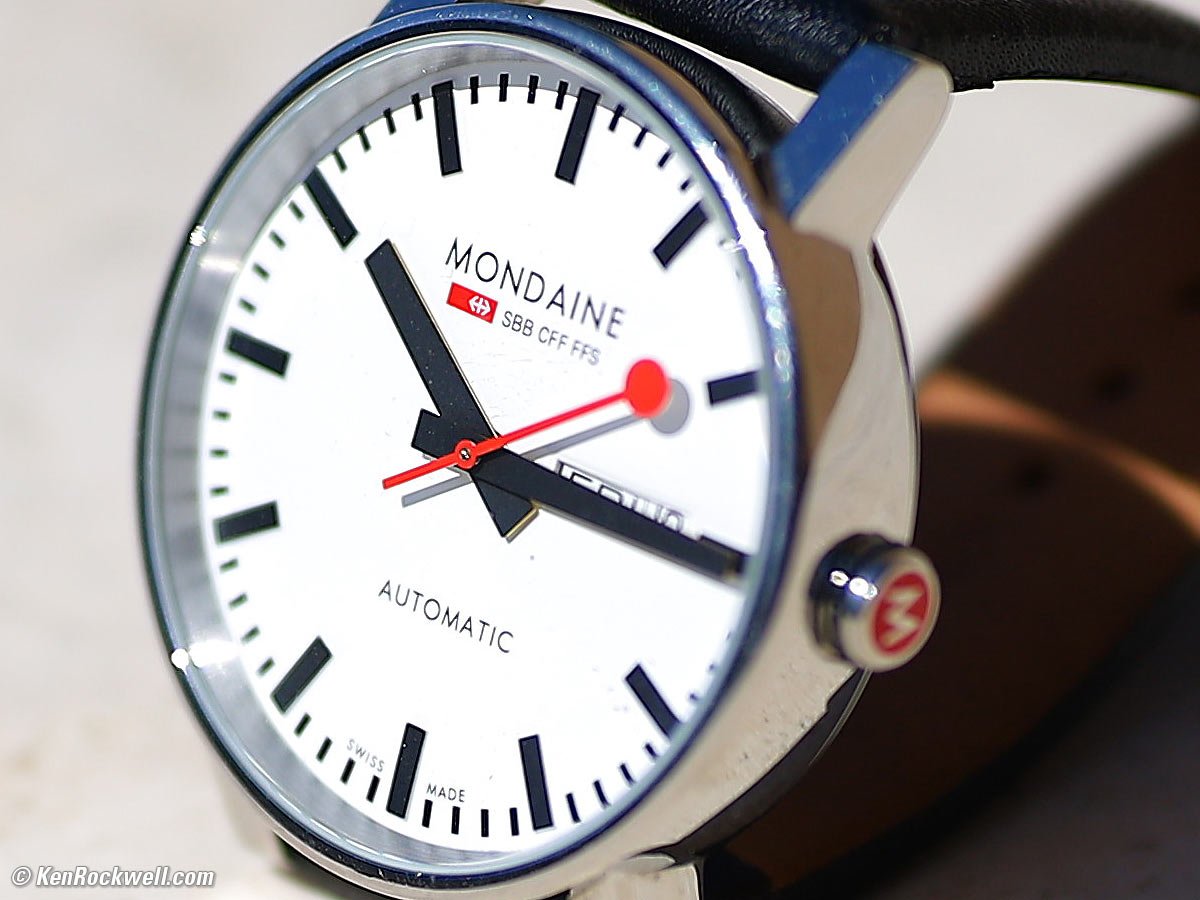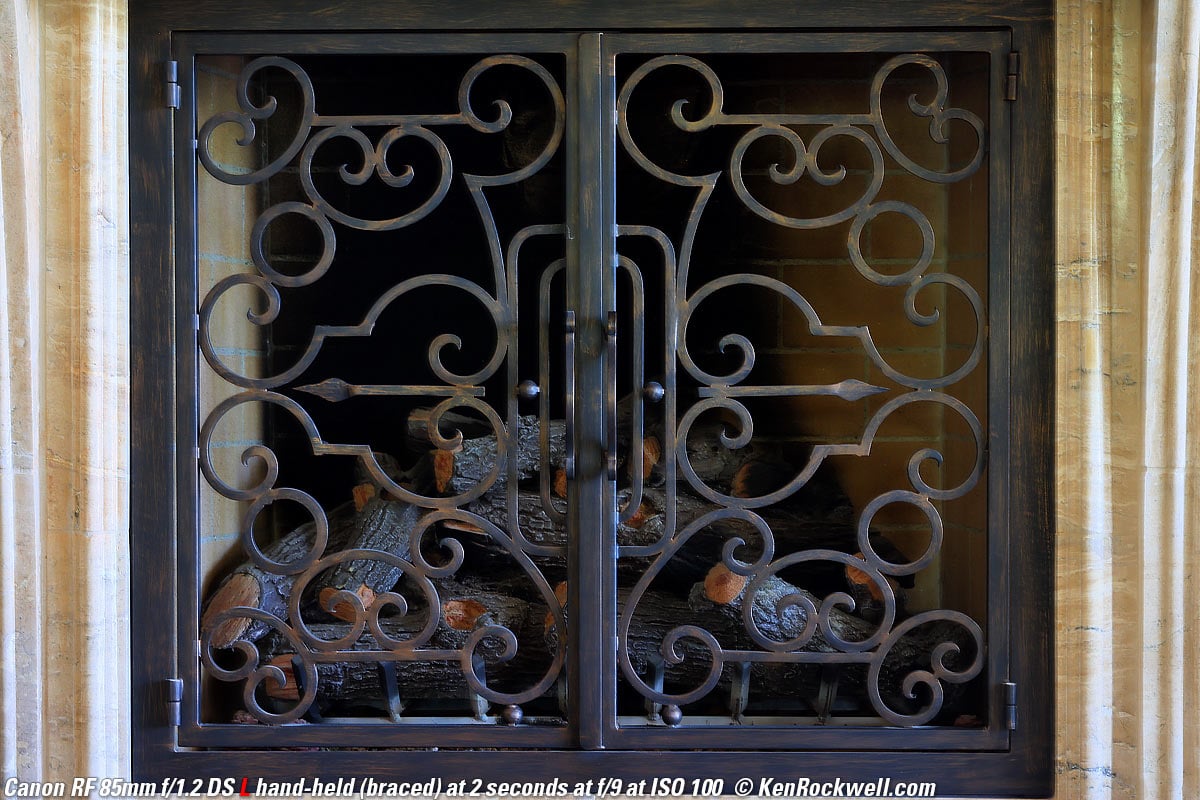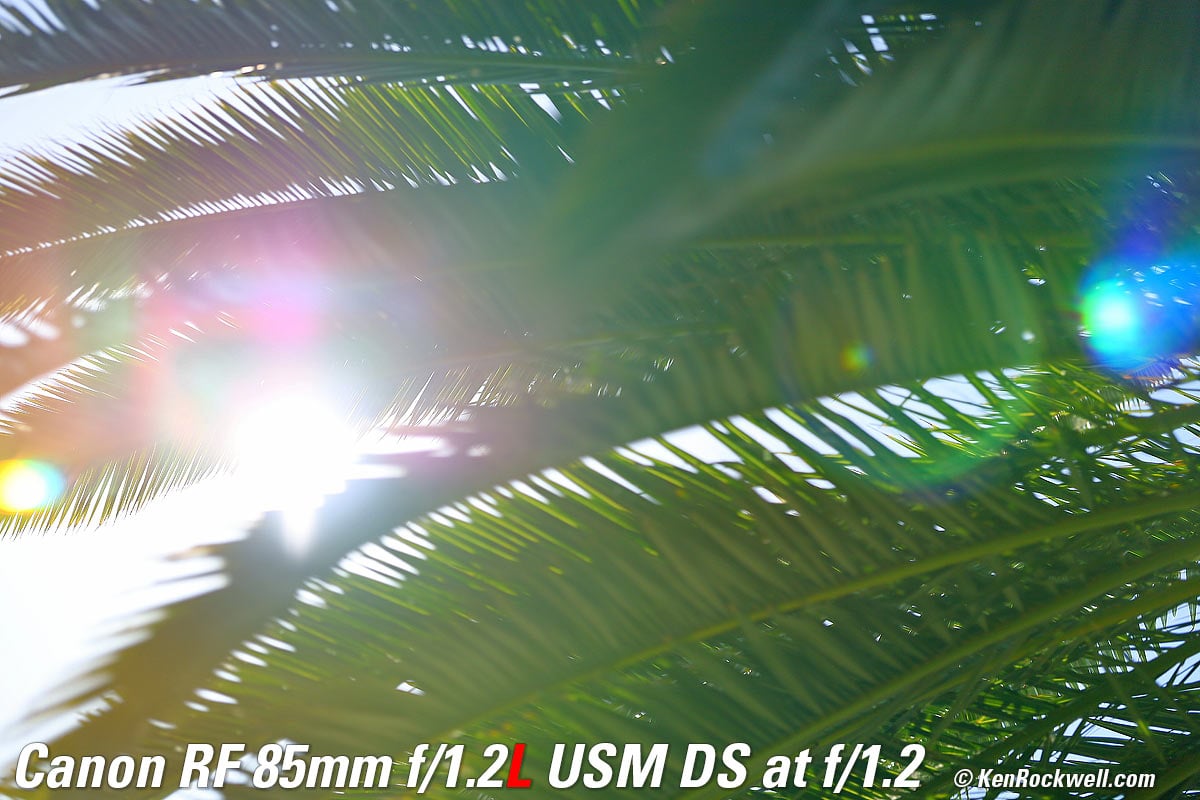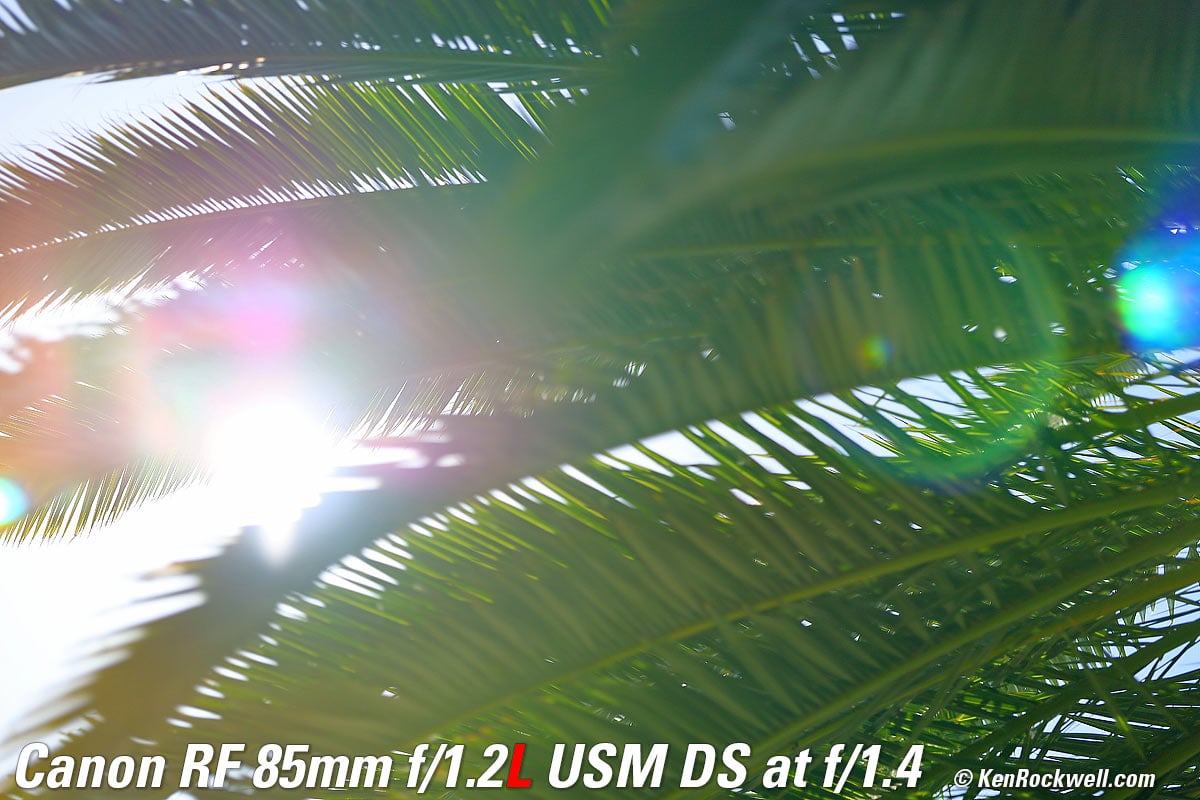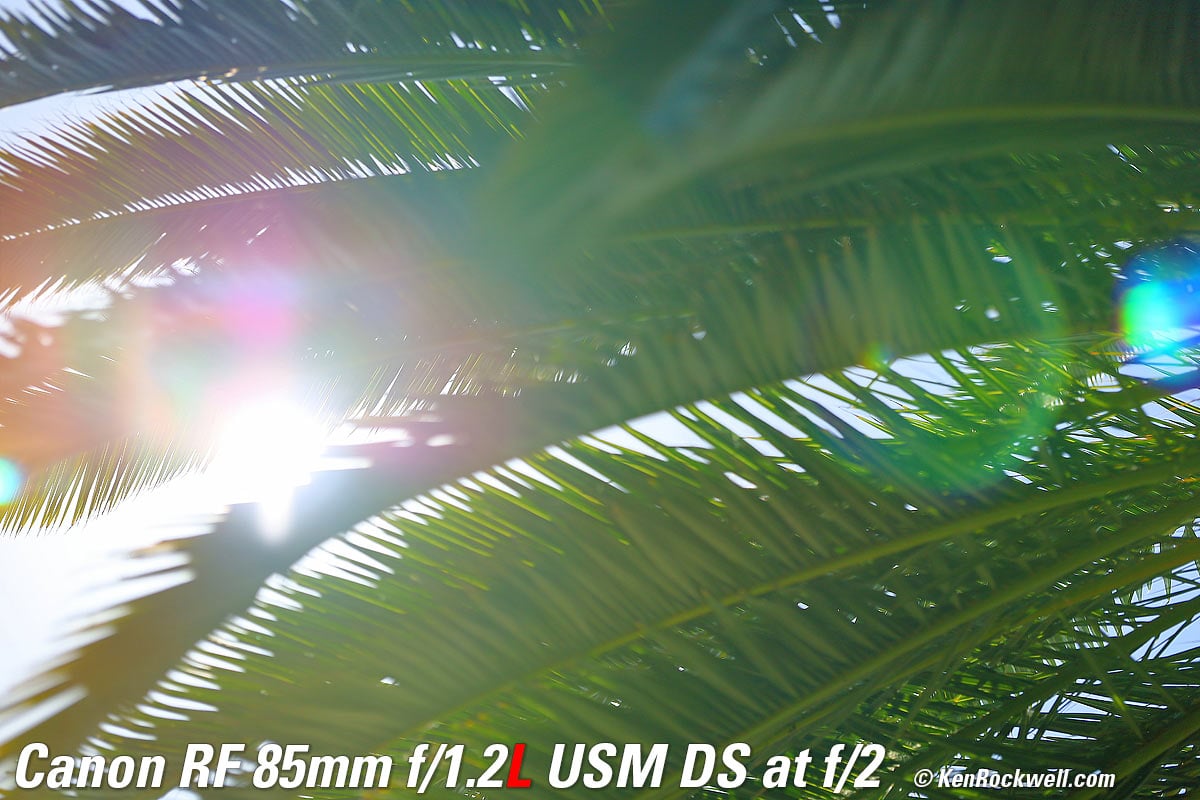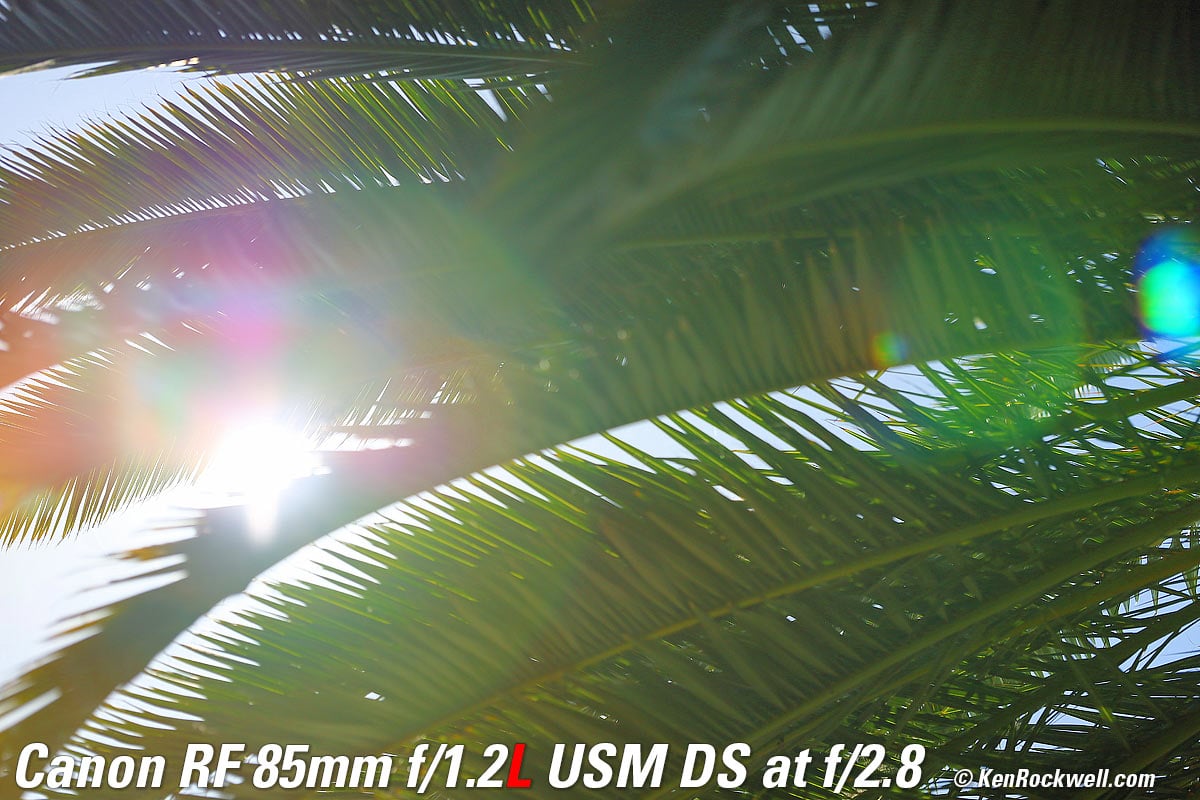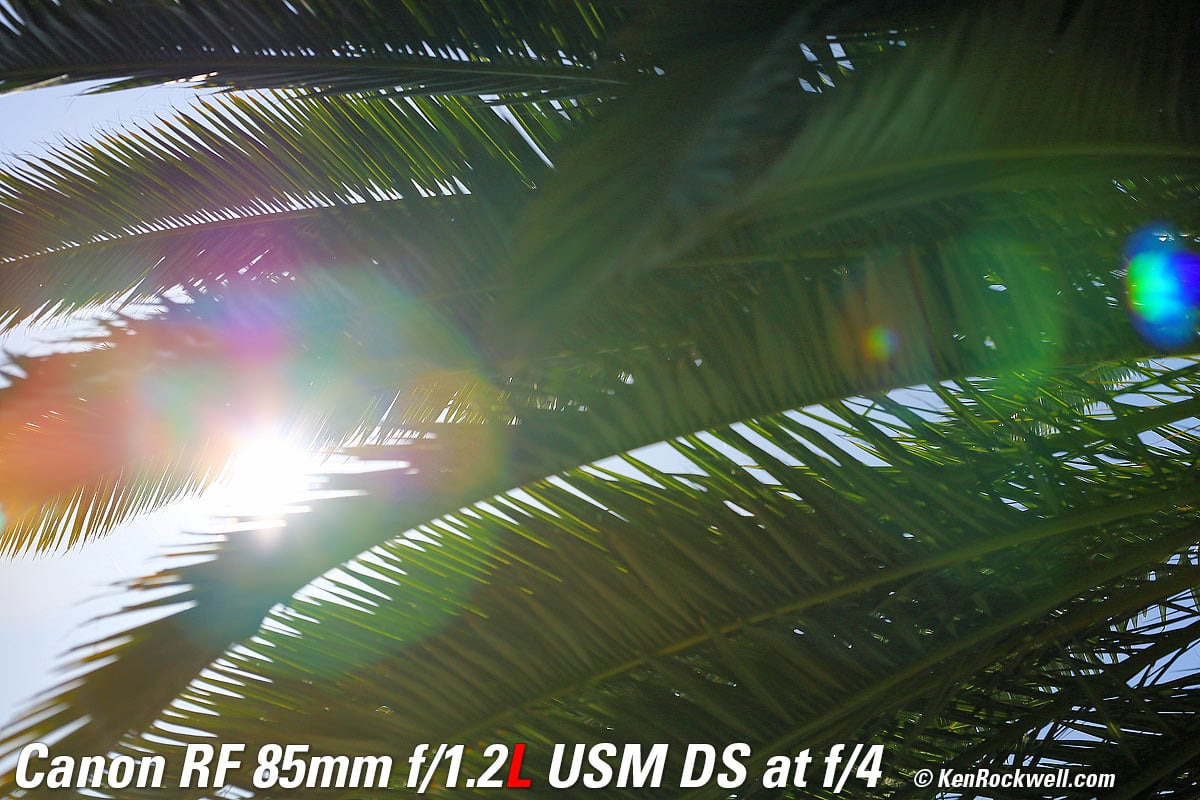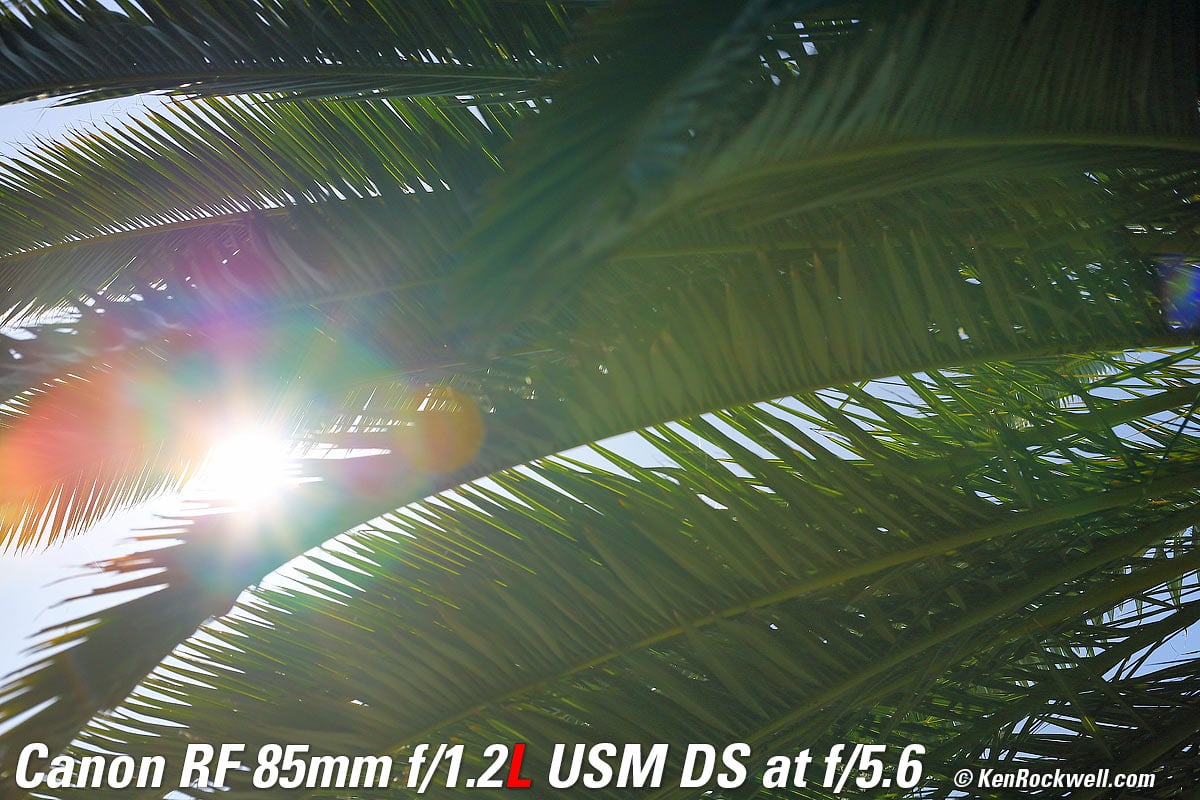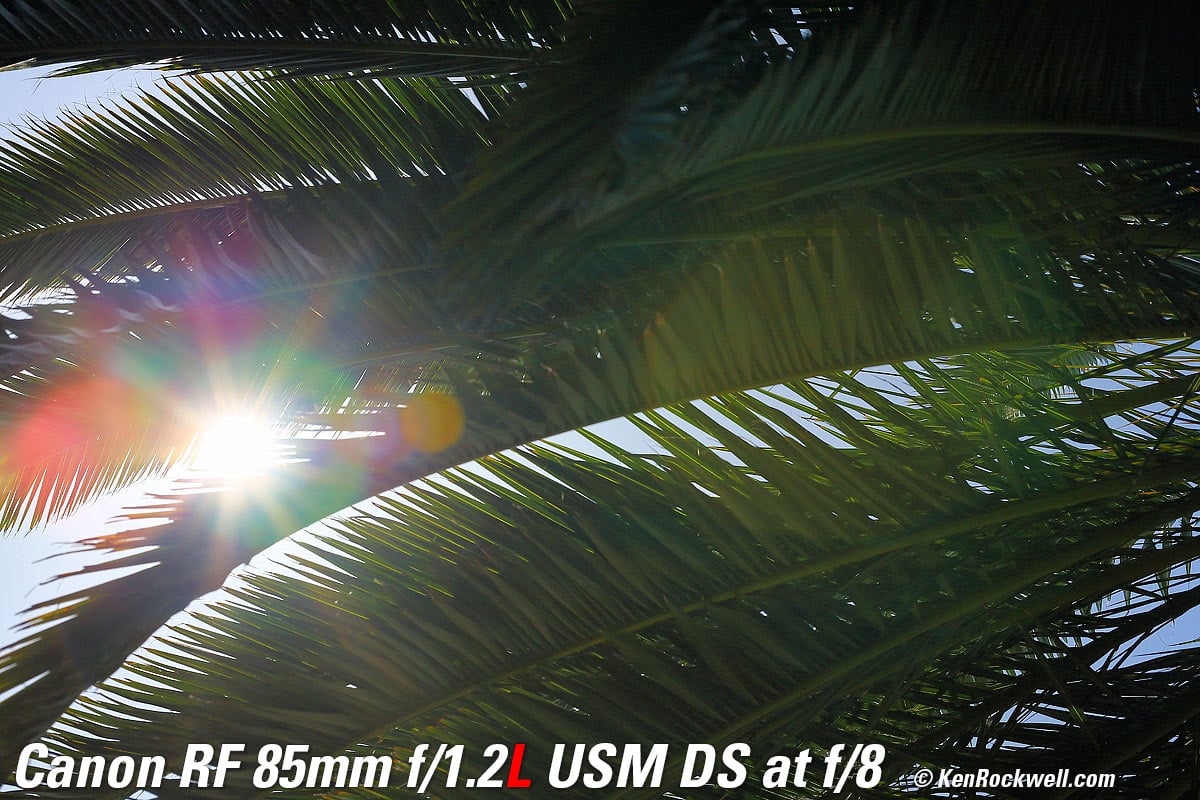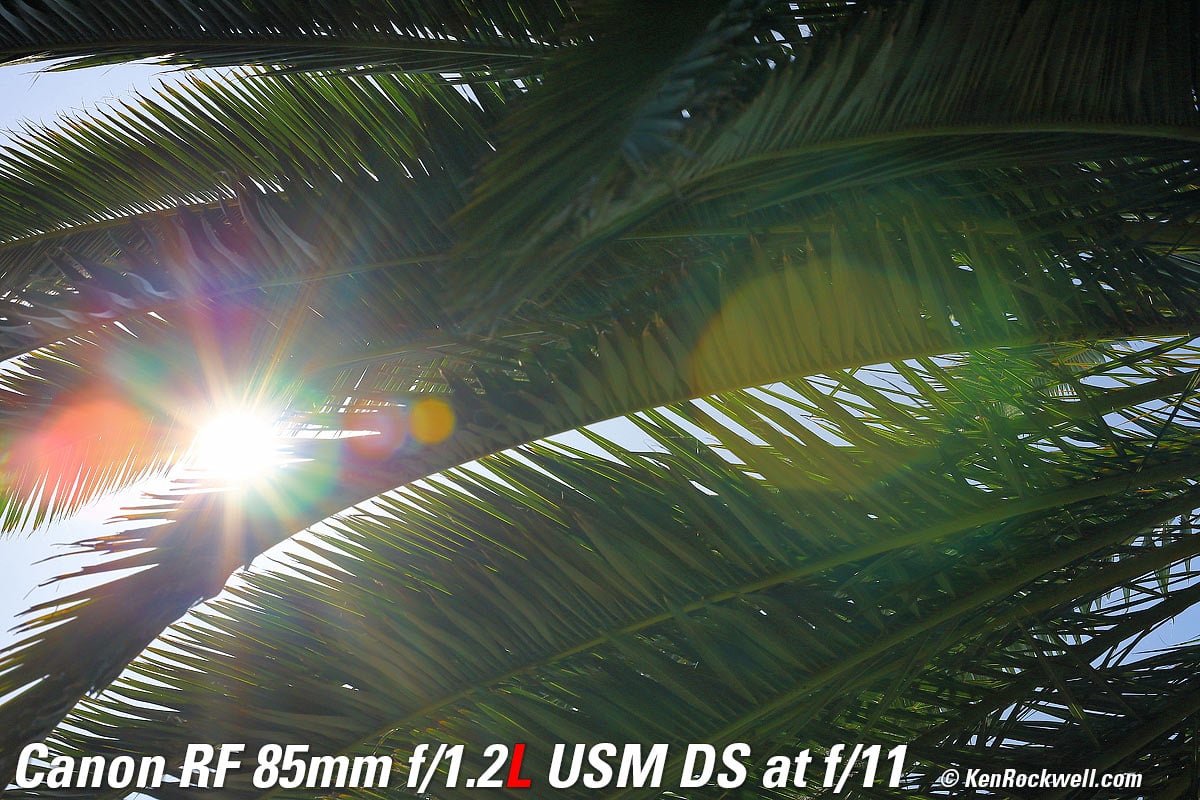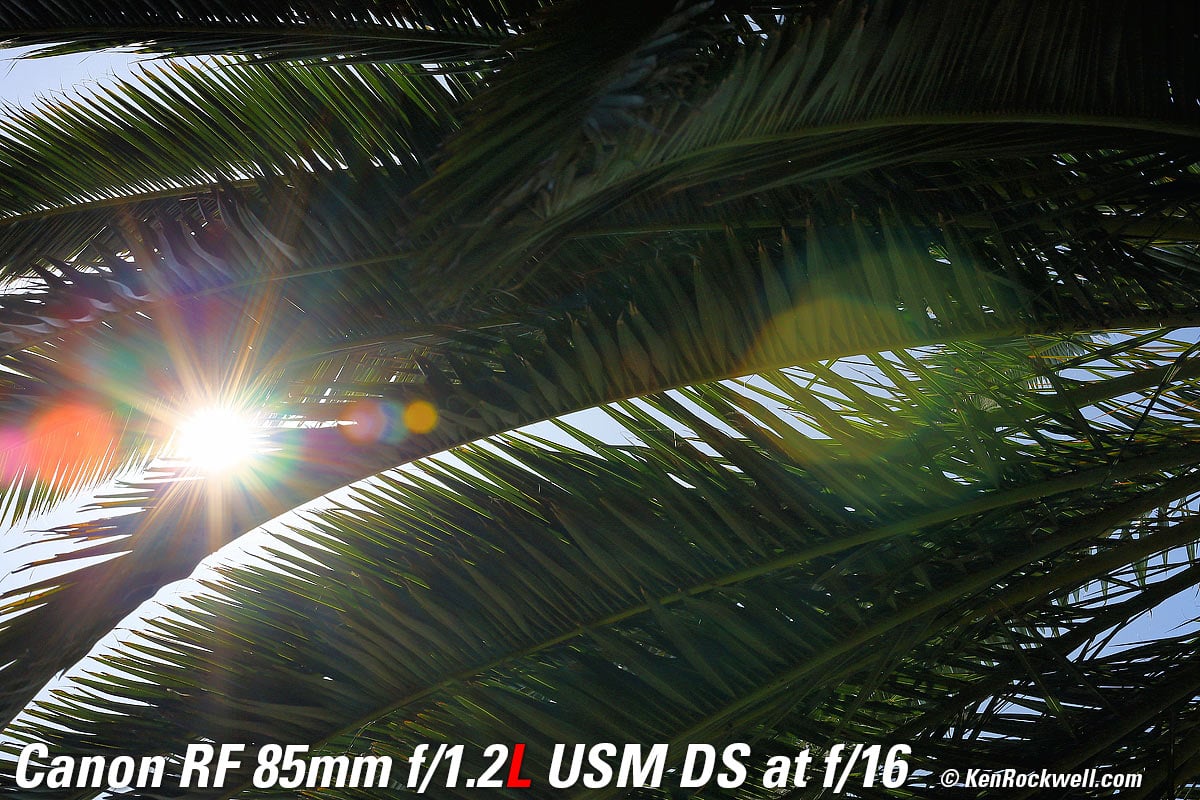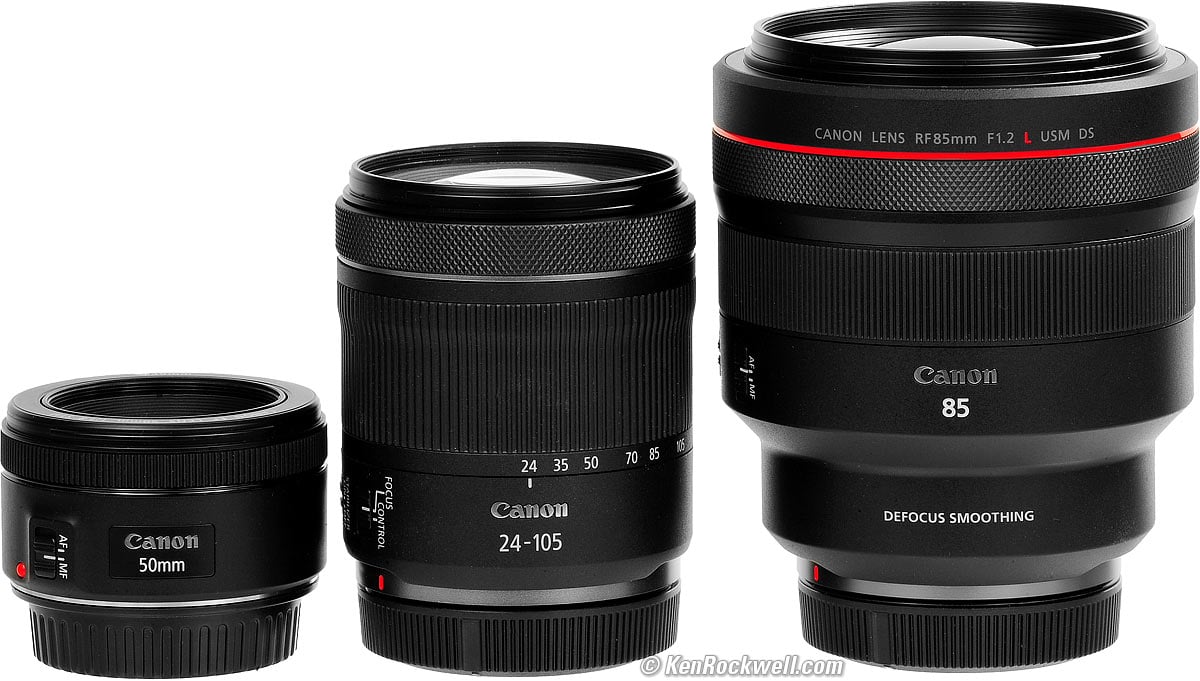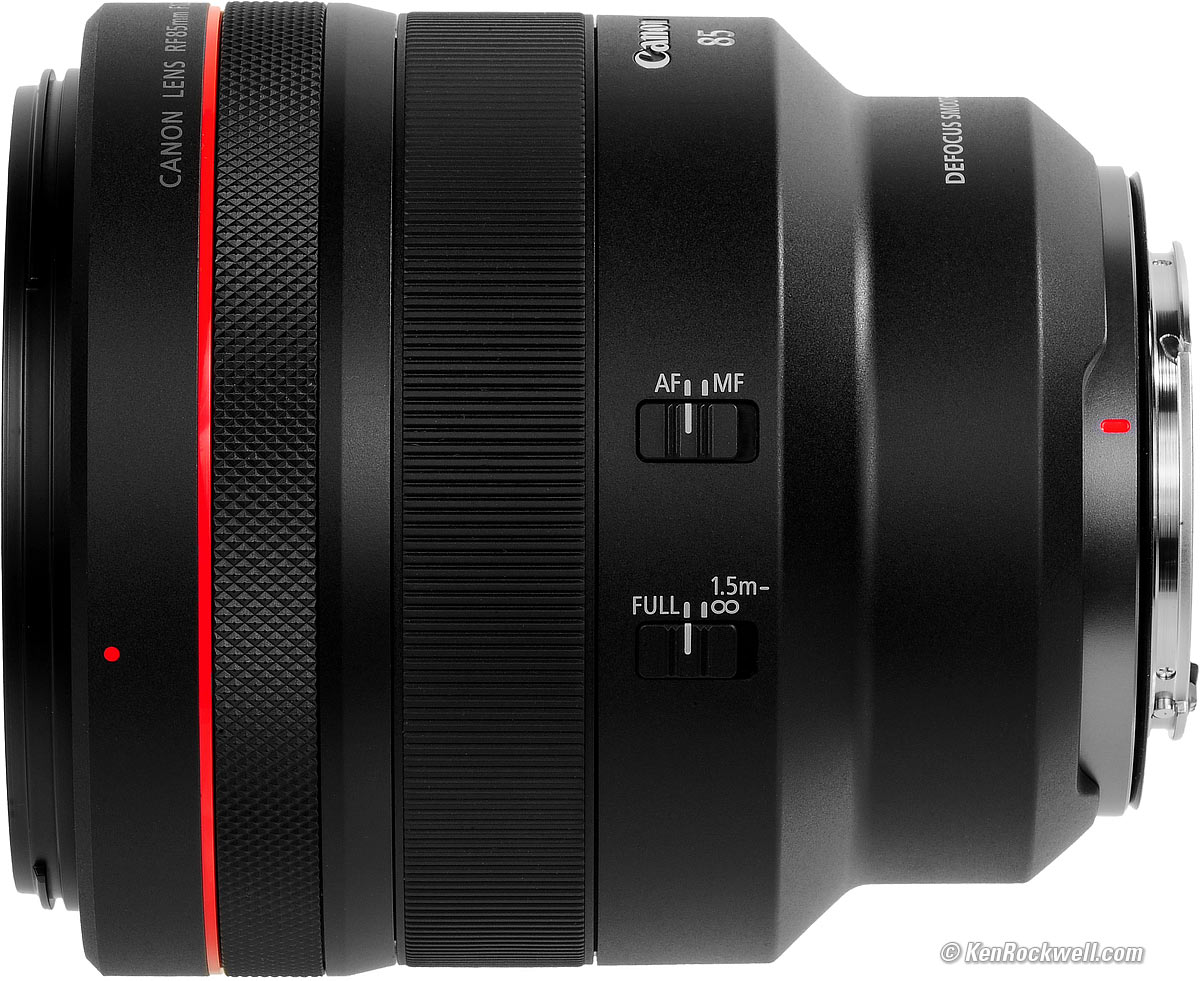Canon RF 85mm f/1.2L DS
Full Frame Mirrorless USM
Optical Perfection & Ultra-Smooth Bokeh
Sample Images Intro Compatibility
Specifications Performance Compared
R3 R5 R5C R6 II R6 R R8 RP R7 R10 R50 R100
Bodies Compared RF Lenses EF Lenses Flash
Canon RF 85mm f/1.2L USM DS (82mm filters, 41.9 oz./1,187g, 2.8'/0.85m close focus, $2,899). bigger. I got mine at B&H. I'd also get mine at Adorama, at Amazon or at at Crutchfield, or used at eBay if you know How to Win at eBay.
This all-content, junk-free website's biggest source of support is when you use those or any of these links to approved sources when you get anything, regardless of the country in which you live. Thanks for helping me help you! Ken.
January 2023 Better Pictures Canon Reviews Mirrorless RF Lenses EF Lenses Flash All Reviews
RF 85mm f/1.2L USM is the same thing, but without the internal bokeh-smoothing edge-graduated neutral density filter.
RF 85mm f/1.2L versus f/1.2L DS
Why Fixed Lenses Take Better Pictures
Sample Images top
Sample Images Intro Compatibility
Specifications Performance Compared
These are just snapshots and there are many more throughout the review; my real work is in my Gallery.
These are all shot hand-held as NORMAL JPGs; no tripods, FINE JPGs or RAW CR3 files were used or needed.
Wide-Open at f/1.2:
2017 Specialized Tarmac Comp 58cm, Torch Edition with orange Presta valve caps, Shimano Dura-Ace CS-R9100 12-25T cassette, Shimano Integra FC-R8000 175mm 46-36T crankset and Shimano Dura-Ace PD-R9100 pedals, 8:54 AM, 09 August 2020. Canon EOS R5, Canon RF 85mm f/1.2L USM DS wide-open at f/1.2 at 1/6,400 at ISO 50, -2 stops exposure compensation to keep the brilliant torch orange from clipping the red channel (LV 14¼), as shot. bigger or camera-original © JPG file.
How sharp is this combination of state-of-the art lens and camera? Sharp enough to read the fine print off my old tires, and this is wide-open at f/1.2 with about a half-inch (one cm) of depth-of-field!
1,200×900 pixel (6.8× magnification) crop from above. bigger or camera-original © JPG file.
If this 1,200 × 900 pixel crop is about 3" (7.5cm) wide on your screen, the complete image would print at a large 14 × 21″ (35 × 55 cm) at this same high magnification.
If this 1,200 × 900 pixel crop is about 6" (15cm) wide on your screen, the complete image would print at a huge 27½ × 41¼″ (2¼ × 3½ feet or 70 × 105 cm) at this same high magnification.
If this 1,200 × 900 pixel crop is about 12" (30cm) wide on your screen, the complete image would print at a mammoth 55 × 82½″ (4½ × 7 feet or 1.4 × 2.1 meters) at this same extremely high magnification — larger than life-sized!!!
Wide-Open at f/1.2:
Desert Golf Course, 8:19 AM, 18 July 2020. Canon EOS RP, Canon RF 85mm f/1.2L USM DS wide-open at f/1.2 at 1/2,500 at ISO 50 (LV 13.0), Perfectly Clear. bigger, full-resolution or camera-original © JPG file.
Remember, at f/1.2 even at this distance the depth-of-field is only about three feet. The foreground and the background are supposed to be soft; only some of the palm trees and the tree on the right are in any sort of focus.
Introduction top
Sample Images Intro Compatibility
Specifications Performance Compared
|
I buy only from these approved sources. I can't vouch for ads below. |
This is an ultra, ultrasharp professional short telephoto for Canon's EOS-R mirrorless system.
This DS "Defocus Smoothing" lens has two additional non-removable dark-edged graduated "apodization" neutral-density filter coatings compared to the regular RF 85mm f/1.2L:
RF 85mm f/1.2L DS internal optical construction. Note two filter coatings. bigger.
Canon creates these filters by painting the edges of two elements progressively darker (called Vapor-Deposited Edge-Graduated Neutral-Density Filter Coatings in tech jargon), so that instead of out-of-focus points of light rendering as hard-edged blur circles, these circles instead become soft blobs due to the darker edges of the internal filters.
While looking through the regular RF 85mm f/1.2L shows just a clear circle like most lenses, you can see the effects of the dark-edged filters in this Defocus Smoothing (DS) version. They smooth the transition between the clear center area and the black edge:
Canon RF 85mm f/1.2L USM DS. bigger.
This makes out-of-focus points of light appear not simply as hard-edged circles as they do with most lenses, but instead as soft blobs with no edge, just as you see when looking through the lens like this.
These edge-graduated internal ND filters soften the edges of blur circles, and also lower light transmission at large apertures. Shot at f/1.2, this DS lens transmits about as much light as an f/2 lens. Your camera will set ISO and shutter speed accordingly.
Smooth bokeh comes from having no hard edges on defocused points of light, also called blur circles. The blur circles from the DS lens at f/1.2 aren't circles or discs; they're simply nondescript Gaussian blobs with no edges and therefore no ability to create distractions in the background from "false resolution" caused by hard edges. No matter how far out of focus something may be, if you have points of light in the subject they can create hard-edged circles in defocused backgrounds, making backgrounds unsmooth, busy or distracting.
The differences between these lenses are most obvious at f/1.2. At smaller apertures, say by f/2 and smaller, the diaphragm covers the softly graduated edges of the apodization filters, and the effect goes away. If you're shooting at apertures from about f/2.8 and smaller, these lenses perform exactly the same. Even at f/2 they perform almost identically; the differences are only apparent wide-open at f/1.2 and f/1.4.
Get this DS version for portraits or any other use where we want soft, smooth and undistracting backgrounds. Both versions of the 85mm f/1.2 are ultra-sharp when in focus.
This lens is not as fast in low light as the regular RF 85mm f/1.2 lens because of these non-removable internal filters.
I got my 85/1.2L DS at B&H. I'd also get mine at Adorama, at Amazon or at at Crutchfield, or used at eBay if you know How to Win at eBay.
New intro top
 Canon's first lens with an apodization filter for ultimate bokeh.
Canon's first lens with an apodization filter for ultimate bokeh.
Good intro top
 Great bokeh due to the edge-graduated apodization filter.
Great bokeh due to the edge-graduated apodization filter.
 Built-in edge grad filter lets us shoot at f/1.2 in daylight without needing an external ND filter.
Built-in edge grad filter lets us shoot at f/1.2 in daylight without needing an external ND filter.
 Optical perfection: no sharper lens has ever legally been sold to the public or outside the surveillance, national intelligence and satellite communities.
Optical perfection: no sharper lens has ever legally been sold to the public or outside the surveillance, national intelligence and satellite communities.
 Second programmable control ring.
Second programmable control ring.
 Made in Japan.
Made in Japan.
 100% U.S.A.-based high-quality technical support at (800) OK-CANON.
100% U.S.A.-based high-quality technical support at (800) OK-CANON.
 Like other L lenses, gasketed against the elements:
Like other L lenses, gasketed against the elements:
Canon RF 85mm f/1.2L USM DS Gasketing.
Bad intro top
 The apodization filter which creates the awesome bokeh absorbs enough light to make this only as fast as an f/2 lens when set to f/1.2 (it's T2 in motion-picture terms); there's no free lunch with neutral-density filters.
The apodization filter which creates the awesome bokeh absorbs enough light to make this only as fast as an f/2 lens when set to f/1.2 (it's T2 in motion-picture terms); there's no free lunch with neutral-density filters.
 Big.
Big.
 Heavy.
Heavy.
Missing intro top
 No Image Stabilization, but the R5's IBIS adds two real stops of improvement.
No Image Stabilization, but the R5's IBIS adds two real stops of improvement.
 Nothing; comes with front and rear caps, LP-1424 case and ET-89 hood and lifetime U.S.A.-based high-quality technical support at (800) OK-CANON.
Nothing; comes with front and rear caps, LP-1424 case and ET-89 hood and lifetime U.S.A.-based high-quality technical support at (800) OK-CANON.
Canon RF 85mm f/1.2L USM DS. bigger.
Compatibility top
Sample Images Intro Compatibility
Specifications Performance Compared
I got my 85/1.2L DS at B&H. I'd also get mine at Adorama, at Amazon or at at Crutchfield, or used at eBay if you know How to Win at eBay.
Canon RF 85mm f/1.2L USM DS on EOS RP. bigger.
This lens only works on Canon's EOS-R series of mirrorless cameras.
It won't work with any teleconverters.
It won't fit on, and cannot be adapted to, any DSLR because a DSLR has too much distance between its sensor and its lens mount flange.
Specifications top
Sample Images Intro Compatibility
Specifications Performance Compared
I got my 85/1.2L DS at B&H. I'd also get mine at Adorama, at Amazon or at at Crutchfield, or used at eBay if you know How to Win at eBay.
Name specifications top
Canon calls this the Canon RF85mm F1.2L USM DS:
RF: Works only on Canon's EOS-R Mirrorless cameras.
L: Expensive as L.
USM: Ring-Type UltraSonic (autofocus) Motor.
DS: Defocus Smoothing, uses internal edge-graduated neutral-density filters to soften the edges of out-of-focus blur circles.
Optics specifications top
Canon RF 85mm f/1.2L USM DS internal optical construction. Regular Optical Glass, UD glass and Ground Aspherical elements and Blue-Spectrum Refractive Compound. bigger.
13 elements in 9 groups.
1 UD extra-low dispersion element, which helps reduce secondary axial chromatic aberration.
1 Ground Aspherical element.
Vapor-deposited edge-graduated neutral-density filter coatings to soften blur circle edges at f/1.2. (Ineffective at smaller apertures.)
Blue-Spectrum Refractive Compound squirted in the airspace between two elements to reduce secondary axial chromatic aberration and spherochromatism:
Without BR Compound. bigger. |
With BR Compound. bigger. |
Multicoated, one surface sub-wavelength coated.
Front fluorine coating to resist dirt and smudges.
Filters specifications top
82 mm filter thread.
Coverage specifications top
Full-Frame (24 × 36mm) and APS-C (16 × 24mm).
Diaphragm specifications top
Canon RF 85mm f/1.2L USM DS. bigger.
9 rounded blades.
Electronically actuated.
Stops down to f/16.
Angles of View, Full-Frame specifications top
28.5º diagonal.
24º horizontal.
16º vertical.
Autofocus specifications top
Ring-type USM (UltraSonic autofocus Motor).
Focus Scale specifications top
Not on lens, may be in camera.
Infinity Focus Stop specifications top
No.
Depth of Field Scale specifications top
No.
Infrared Focus Index specifications top
No.
Close Focus specifications top
2.79 feet (0.85 meters).
Maximum Reproduction Ratio specifications top
1:8.3 (0.12×).
Reproduction Ratio Scale specifications top
No.
Image Stabilizer specifications top
None.
Caps specifications top
Lens Cap E-82II front cap, included.
Rear Lens Dust Cap RF (p/n 2962C001), included.
Hood specifications top
ET-89 hood (part number 3448C001), included.
Case specifications top
LP-1424 carry sack, included.
Size specifications top
4.06" Ø maximum diameter × 4.62" extension from flange.
103.2 mm Ø maximum diameter × 117.3 mm extension from flange.
Weight specifications top
41.860 oz. (1,186.8 g) actual measured weight.
Rated 42.2 oz. (1,195g).
Development Announced specifications top
11 PM Wednesday, 13 February 2019, NYC time, at which time it was promised for "later in 2019."
Announced and First Offered for Sale specifications top
12:01 AM Thursday, 24 October 2019, NYC time.
Shipping promised for specifications top
December 2019.
Quality specifications top
Canon RF 85mm f/1.2L USM DS. bigger.
Made in Japan.
Included specifications top
ET-89 hood (part number 3448C001).
Lens Cap E-82II front cap.
Rear Lens Dust Cap RF (p/n 2962C001).
Canon's Model Numbers specifications top
Model Number: RF8512LUDS.
Product Code: 3450C002 in USA; 3450C001 in Japan.
JAN Code: 4549292-159608.
Price, U. S. A. specifications top
January 2023
$2,899 at B&H, at Adorama, at Amazon or at at Crutchfield.
About $2,300 used at eBay if you know How to Win at eBay.
July 2022
$3,099 at B&H, at Adorama, at Amazon or at at Crutchfield.
About $2,600 used at eBay if you know How to Win at eBay.
October 2019 ~ August 2020
$2,999 at B&H, at Adorama, at Amazon or at at Crutchfield.
Performance top
Sample Images Intro Compatibility
Specifications Performance Compared
Overall Autofocus Manual Focus Breathing
Bokeh Distortion Ergonomics Exposure Falloff
Filters Flare & Ghosts Lateral Color Fringes
Lens Corrections Macro Mechanics Sharpness
Spherochromatism Stabilization Sunstars
I got my 85/1.2L DS at B&H. I'd also get mine at Adorama, at Amazon or at at Crutchfield, or used at eBay if you know How to Win at eBay.
Overall performance top
This lens is optically perfect.
It's big, heavy and expensive. Canon cut no corners doing this.
Your biggest question is do you want the magic bokeh of this lens, or want the faster low-light speed of the regular, non-apodized RF 85mm f/1.2L USM?
Autofocus performance top
Autofocus speed is only moderate.
It's not ultra-fast because it's optimized for precision and accuracy over speed. If you want speed, the RF 24-240mm IS and RF 70-200mm f/2.8L IS autofocus much faster.
Manual Focus performance top
Manual focusing is entirely electronic; the manual focus ring isn't connected to anything other than a digital encoder.
How to get manual-focus override.
Focus Breathing performance top
Focus breathing is the image changing size as focused in and out. It's important to cinematographers that the image not breathe because it looks funny if the image changes size as focus gets pulled back and forth between actors. If the lens does this, the image "breathes" by growing and contracting slightly as the dialog goes back and forth.
The image from this RF 85mm f/1.2L USM DS grows larger as focused more closely.
Bokeh performance top
Bokeh, the feel, character or quality of out-of-focus areas as opposed to how far out of focus they are, is world-class apodized Gaussian blur. That's the whole point of this lens.
The apodization filter is most effective wide-open at f/1.2. It has no effect at smaller apertures, at which this lens does exactly the same thing as the regular RF 85mm f/1.2L.
Here's a snap, focused in the middle of the lamp shade. Notice how everything else just melts away, near or far, without spherochromatic color fringes.
Lampshade, 11:15 AM, 09 August 2020. Canon EOS R5, Canon RF 85mm f/1.2L USM DS wide-open at f/1.2 at 1/125 at Auto ISO 1,600 (LV 3.6). bigger or camera-original © JPG file.
In the camera-original © JPG file you can see every thread in the lampshade where it's in focus, and everything else melts away. Brilliant!
Here are photos from headshot distance wide-open. Click any for the camera-original © files:
Made-in-U. S. A. Davis 6250 weather station, 10 July 2020. Canon EOS RP, Canon RF 85mm f/1.2L USM DS at f/1.2, f/2.8, f/5.6 and f/11at 1/4,000, 1/4,000, 1/1,250 and 1/400 at ISO 50, ISO 100, ISO 100 and ISO 100.
Click any for the camera-original © files.
Scarecrow Owl, 28 August 2020. Canon EOS R5, Canon RF 85mm f/1.2L USM DS at f/1.2 at 1/2,000 at Auto ISO 100 (LV 11.6). bigger or camera-original © file.
Lampshade, 12:18 PM, 27 August 2020. Canon EOS R5, Canon RF 85mm f/1.2L USM DS wide-open at f/1.2 at 1/50 at ISO 400 (LV 4¼). bigger or camera-original © JPG file.
Note: the apodization filter makes f/1.2 work like f/2 but has no effect at the middle and smaller apertures. That's why the shutter speeds and ISOs don't make sense at face value.
As always, if you want to throw the background as far out of focus as possible, shoot at f/1.2 and get as close as you can.
Distortion performance top
There is no measurable distortion, meaning whatever distortion may be requires less than a ±0.05 correction factor in Photoshop's lens correction filter, with or without my camera's distortion correction option ON or OFF.
BRAVO!
Perfection!
Ergonomics performance top
Canon RF 85mm f/1.2L USM DS. bigger.
This is a whale of a lens, a little bigger than a large grapefruit and weighing over 2½ pounds (see compared). Once you're OK with its size, it's straightforward. The rings and switches are all in the right places, which is more than I can say for some of Sony's lenses that put vanity nameplates where some switches belong.
Exposure performance top
You can ignore this section unless you're using an external exposure meter or the sort of person who looks at his exposure data and pays way too much attention to it.
The apodization (edge-graduated neutral-density) filter robs a stop and a half at full aperture, meaning that f/1.2 transmits about as much light as a regular f/2 lens. In movies, we call this a T2 lens, meaning it transmits about as much a a perfect f/2 lens.
Since the edge filter has most of its effect at the edges, it has little to no effect at middle and small apertures.
Therefore your Tstop will be much less than your f/stop wide-open, less than your f/stop at large apertures, and they become pretty much the same at f/5.6 and smaller.
Falloff performance top
Falloff is invisible, at least if you leave Peripheral Illumination Correction at its default of ON.
I've greatly exaggerated the falloff by shooting a gray field and placing these on a gray background; it will not look this bad in actual photos of real things:
Falloff on Full-Frame at infinity, correction left at its default of ON.
© 2020 KenRockwell.com. All rights reserved. |
If you go out of your way to turn off the automatic correction, you will see a little — although it's exaggerated here by shooting flat walls:
Falloff on Full-Frame at infinity, correction turned OFF.
© 2020 KenRockwell.com. All rights reserved. |
Filters, use with performance top
There's no need for thin filters. I can stack a few regular 82mm filters without any vignetting.
Go ahead and use your standard rotating polarizer and grad filters.
Flare & Ghosts performance top
I don't see anything unusual here.
See examples at Sunstars.
Lateral Color Fringes performance top
There are no color fringes when shot as JPG with the default Chromatic Aberration Correction (a component of the Digital Lens Optimizer) left ON.
If you go out of your way to turn this OFF (or shoot raw and then use non-manufacturer software to process that data into images) then there still are no fringes! Even on my 45MP EOS R5 at high magnification I can only barely imagine a fraction of a pixel of yellow-blue, but that's just my imagination. This lens ha no fringing!
This is superb performance! Lenses never used to be this good. Even without correction there is no fringing. Bravo!
Lens Corrections performance top
Other cameras may vary, but my EOS R5 and EOS RP both have options to correct for falloff (Peripheral Illumination Correction), Distortion and Digital Lens Optimizers which correct for a suite of other aberrations.
Falloff and the Digital Lens Optimizer are ON by default.
This lens has no distortion, so Distortion correction is OFF by default.
If you turn off the Digital Lens Optimizer, you are then offered à la carte ON/OFF options for Chromatic Aberration Correction and Diffraction Correction — at least on my EOS R5 and EOS RP.
Macro Performance performance top
Macro performance is the same as every other 85mm lens made since the 1960s, focusing to 0.85m. Nothing special here. If you want macro, get the RF 85mm f/2 IS STM Macro instead.
Casio G-Shock Solar Atomic Watch at f/1.2 at close-focus distance, 10 July 2020. Canon EOS RP at ISO 50 at 1/3,200. bigger or camera-original © file.
It doesn't get any closer than classic lenses, but it is ridiculously sharp, even wide-open at f/1.2 (remember there is zero depth-of-field at macro distances at f/1.2):
1,200 × 900 pixel (5.2× magnification) crop from above. bigger or camera-original © file.
If this 1,200 × 900 pixel crop is about 3" (7.5cm) wide on your screen, the complete image would print at a large 14 × 21″ (35 × 55 cm) at this same high magnification.
If this 1,200 × 900 pixel crop is about 6" (15cm) wide on your screen, the complete image would print at a huge 27½ × 41¼″ (70 × 105 cm) at this same high magnification.
If this 1,200 × 900 pixel crop is about 12" (30cm) wide on your screen, the complete image would print at a mammoth 55 × 82½″ (1.4 × 2.1 meters) at this same extremely high magnification!
Mechanical Quality performance top
Canon RF 85mm f/1.2L USM DS. bigger.
It's plastic on the outside, which belies it's heavy-metal insides. This is a very well made lens.
Like many Canon pro lenses, it's plastic on the outside so your fingers don't freeze to it in the cold, and so it bounces rather than dents when dropped — but it's all metal inside.
This is much better than dinky plastic lenses from Zeiss and from Sony which are mostly plastic, but use metal exterior trim just to fool people.
Hood
Plastic bayonet.
Locking latch.
Front Bumper
None.
Filter Threads
Plastic.
Hood Bayonet Mount
Plastic.
Front Barrel Exterior
Plastic.
Programmable Control Ring
Plastic.
Mid Barrel Exterior
Plastic.
Focus Ring
Rubber-covered plastic.
Slide Switches
Plastic.
Rear Barrel Exterior
Plastic.
Identity
Printed around top of lens near the front, also an engraved "85" on the top of the barrel.
Internals
Seem like all metal!
Dust Gasket at Mount
Yes.
Mount
Dull chromed metal.
Markings
All paint, except for engraved "85" on top of barrel.
Serial Number
Canon RF 85mm f/1.2L USM DS. bigger.
Laser engraved in black-on-black on bottom of barrel.
Yes, I really got serial number ONE from B&H. That's fast service!
Date Code
None found.
Noises When Shaken
Almost NOTHING. I can almost imagine a few diaphragm blades, but overall you really have to hold on tight to shake this beast enough even to imagine any noises.
Made in
Lens made in Japan.
Sharpness performance top
Lens sharpness has nothing to do with picture sharpness; every lens made in the past 100 years is more than sharp enough to make super-sharp pictures if you know what you're doing. The only limitation to picture sharpness is your skill as a photographer. It's the least talented who spend the most time worrying about lens sharpness and blame crummy pictures on their equipment rather than themselves. Skilled photographers make great images with whatever camera is in their hands; I've made some of my best images of all time with an irreparably broken camera! Most pixels are thrown away before you see them, but camera makers don't want you to know that.
If you're not getting ultra-sharp pictures with this, be sure not to shoot at f/11 or smaller where all lenses are softer due to diffraction, always shoot at ISO 100 or below because cameras become softer at ISO 200 and above, avoid shooting across long distances over land which can lead to atmospheric heat shimmer, be sure everything is in perfect focus, set your camera's sharpening as you want it (I set mine to the maximum: 7,5,5) and be sure nothing is moving, either camera or subject. If you want to ensure a soft image with any lens, shoot at f/16 at ISO 6,400 at default sharpening in daylight of subjects at differing distances in the same image.
As the MTF chart confirms, the 85/1.2 DS is essentially flawless:
Canon RF 85 1.2 DS MTF wide-open at 10 cyc/mm (black) and 30 cyc/mm (blue). Sagittal (solid) and meridional (dashed).
Spherochromatism performance top
Spherochromatism, also called secondary spherical chromatic aberration or "color bokeh," is an advanced form of spherical and chromatic aberration in a different dimension than lateral chromatic aberration. It happens mostly in fast normal and tele lenses when spherical aberration at the ends of the color spectrum are corrected differently than in the middle of the spectrum. Spherochromatism can cause colored fringes on out-of-focus highlights, usually seen as green fringes on backgrounds and magenta fringes on foregrounds. Spherochromatism is common in fast lenses of moderate focal length when shooting contrasty items at full aperture. It goes away as stopped down.
Miraculously, there is nearly no spherochromatism in this ultra-speed tele. Canon really did their homework with their "Blue-Spectrum Refractive Compound" to eliminate this:
Mondaine A132.30348.11SBB at close-focus distance at f/1.2, 10 July 2020. Canon EOS RP at ISO 50 at 1/4,000. bigger or camera-original © file.
1,200 × 900 pixel (5.2× magnification) crop from above. bigger or camera-original © file.
If this 1,200 × 900 pixel crop is about 3" (7.5cm) wide on your phone, then the complete image printed at this same high magnification would be about 11 × 16" (0.9 × 1.3 feet or 25 × 40 cm).
If this 1,200 × 900 pixel crop is about 6" (15cm) wide on your screen, then the complete image printed at this same very high magnification would be about 21 × 31" (1.7 × 2.6 feet or 50 × 80 cm).
If this 1,200 × 900 pixel crop is about 12" (30cm) wide on your screen, then the complete image printed at this same extreme magnification would be about 42 × 62" (3.5 × 5.2 feet or 1.05 × 1.6 meters).
Image Stabilization performance top
This 85/1.2 DS has no Optical Image Stabilization, but it does work with the in-body, sensor-shift stabilization of cameras like the EOS R5. On the R5, stabilization is turned ON or OFF at MENU > CAMERA 7 > IS (Image Stabilizer) mode.
"Percent Perfectly Sharp Shots" are the percentage of frames with 100% perfect tripod-equivalent sharpness I get when I'm shooting hand-held while free-standing with no support or bracing. Hand tremor is a random occurrence, so at marginal speeds some frames will be perfectly sharp while others will be in various stages of blur — all at the same shutter speed. This rates what percentage of shots are perfectly sharp, not how sharp are all the frames:
| % Perfectly Sharp Shots | 2s |
1 |
1/2 |
1/4 |
1/8 |
1/15 |
1/30 |
1/60 |
1/125 |
1/250 |
| Stabilization ON | 0 |
0 |
17 |
5 |
25 |
33 |
83 |
100 |
100 |
100 |
| Stabilization OFF | 0 |
0 |
0 |
0 |
0 |
5 |
17 |
33 |
80 |
100 |
I get 100% perfect tripod-equivalent sharpness most of the time at 1/125 without the stabilizer, and at 1/30 with the stabilizer.
This is a two-stop real-world improvement. It's welcome and helps, but nowhere near as good as Canon claims for the R5. Standing without support, no way am I getting really sharp shots consistently at 2 seconds.
Seeing Canon's claims of "up to 2 seconds" with this lens, I got curious. While standing unbraced and demanding perfect sharpness almost all the time I can only shoot at 1/30, however if I rest my elbows on something solid and make a number of exposures to pick the best one and don't demand perfect tripod-equivalent sharpness, yes, every so often I can get a good-enough shot at 2 seconds:
Fireplace, 11:05 AM, 11 August 2020. Canon EOS R5, Canon RF 85mm f/1.2 DS L handheld (elbows resting on table) at two seconds at f/9 at ISO 100 (LV 5.4), best shot of many blurrier ones, Perfectly Clear. bigger or camera-original © JPG file.
It took many frames to get one this sharp and I was bracing my elbows and chest on a coffee table, so yes, while you can get "sharp enough" shots at two seconds, for perfect sharpness almost all the time while standing unsupported, I need to shoot at at least 1/30. Another trick is of course to rest the camera on something for longer exposures.
It all depends on how you define "hand held" and your standards for sharpness.
Sunstars performance top
With a 9-bladed rounded diaphragm, I don't see much in the way of sunstars on the sun. You may get better on distant points of light at night because they are points rather than the big sun through this telephoto lens.
Ignore the crazy rainbow effects; these are sensor artifacts caused by taking a picture directly of the sun and exposing for the dark underside of the palm tree. Likewise the vertical smear at larger apertures is another sensor artifact called interline transfer smear; it's not a lens defect.
Click any to enlarge:
Click any to enlarge.
Compared top
Sample Images Intro Compatibility
Specifications Performance Compared
I got my 85/1.2L DS at B&H. I'd also get mine at Adorama, at Amazon or at at Crutchfield, or used at eBay if you know How to Win at eBay.
Versus Reasonable Lenses
Canon EF 50/1.8 STM, RF 24-105 STM and RF 85mm f/1.2L USM DS. bigger.
This is a huge lens not to be purchased lightly. It's a special-purpose lens, and even if you win one in the lottery you still will have to carry it around.
Compared to the regular RF 85mm f/1.2L USM
See also RF 85mm f/1.2L versus f/1.2L DS.
The the regular RF 85mm f/1.2L USM is the same lens, minus the internal dark-edged "apodization" filters to smooth bokeh at f/1.2.
While this DS lens has smoother bokeh at f/1.2, the effects of the filter go away at medium and small apertures, so unless you're shooting at large apertures and want that smooth bokeh, you may as well save your money and get the regular version.
Of course if you're not using f/1.2, you may as well get the excellent and much more practical RF 85mm f/2 IS STM Macro.
If you need low-light speed, the regular RF 85mm f/1.2L USM lets in a stop and a half more light at f/1.2 since it doesn't have the edge-grad neutral density filter of the DS version. The regular 85/1.2 really is f/1.2 at f/1.2, while the DS version only lets in as much light at f/1.2 as does a regular f/2 lens.
For low-light, get the regular version.
For insanely smooth bokeh, get this DS version.
User's Guide top
Sample Images Intro Compatibility
Specifications Performance Compared
I got my 85/1.2L DS at B&H. I'd also get mine at Adorama, at Amazon or at at Crutchfield, or used at eBay if you know How to Win at eBay.
Manual-Focus Override
By default, there is no always-responsive instant manual-focus override as we take for granted in our DSLRs.
EOS R cameras need a menu setting changed for manual-focus override, otherwise the focus ring is always ignored in AF.
Find the "Lens electronic AF" option in your AF menu (AF 4 in EOS R5 or CAMERA 8 in EOS RP), and set it to either "One‑Shot‑>enabled" or "One‑Shot‑>enabled (magnify)."
Now manual focus override works if you turn the ring while continuing to hold the shutter halfway, but only after focus locks in ONE SHOT.
Canon RF 85mm f/1.2L USM DS. bigger.
AF - MF Switch user's guide top
AF: Auto Focus.
MF: Manual Focus only.
Full / 1.5m-∞ Switch user's guide top
This is a focus limiter.
Leave it in FULL.
The 1.5m-∞ position prevents the lens from autofocusing closer than 1.5 meters (5 feet). Use this setting only if you're having a problem with the lens attempting to focus on irrelevant close items, or if for some reason the lens is "hunting" from near to far looking for distant subjects.
Vibration Reduction (VR) Control user's guide top
There is no switch on the lens because the lens has no optical stabilization.
If your camera has built-in stabilization, like the EOS R5 and EOS R6, you set this in a menu.
On the EOS R5, set it at MENU > CAMERA 7 > IS (Image Stabilizer) mode.
Recommendations top
Sample Images Intro Compatibility
Specifications Performance Compared
I got my 85/1.2L DS at B&H. I'd also get mine at Adorama, at Amazon or at at Crutchfield, or used at eBay if you know How to Win at eBay.
If you want an ultra-ultrasharp lens with soft, melt-away backgrounds, this is the world's best.
This is a special-purpose lens expressly for people who demand the softest possible out-of-focus areas. It's not a high-speed lens, as the internal neutral-density filters make this lens slower than f/1.2 (about T2). The effects of the internal filters go away at smaller apertures. If you want the same ultra sharpness but want the high speed of f/1.2 with not quite as soft backgrounds, instead get the regular RF 85mm f/1.2L.
I use a clear (UV) protective filter instead of a cap so I'm always ready to shoot instantly. I only use a cap when I throw this in a bag with other gear without padding — which is never. The UV filter never gets in the way, and never gets lost, either.
The very best protective filter is the 82mm Hoya multicoated HD3 UV which uses hardened glass and repels dirt and fingerprints.
For less money, the B+W 82mm 010 is an excellent filter, as is the multicoated version and the Hoya Alpha filter, but the Hoya HD3 is the toughest and the best.
Any of these filters protects as well and gives ultrasharp images, but since filters last a lifetime, you may as well get the best since the Hoya HD3 is tougher and stays cleaner than the others since it repels oil and dirt.
I got my 85/1.2L DS at B&H. I'd also get mine at Adorama, at Amazon or at at Crutchfield, or used at eBay if you know How to Win at eBay.
This 100% all-content website's biggest source of support is when you use those or any of these links to approved sources when you get anything, regardless of the country in which you live. Canon does not seal its boxes in any way, so especially with an exotic lens like this never buy at retail or any other source not on my personally approved list since you'll have no way of knowing if you're missing accessories, getting a defective, damaged, returned, non-USA, store demo or used lens. I use the stores I do because they ship from secure remote warehouses where no one gets to touch your new camera before you do. Buy only from the approved sources I use myself for the best prices, service, return policies and selection.
Thanks for helping me help you!
Ken, Mrs. Rockwell, Ryan and Katie.
© Ken Rockwell. All rights reserved. Tous droits réservés. Alle Rechte vorbehalten.
Help Me Help You
I support my growing family through this website, as crazy as it might seem.
The biggest help is when you use any of these links when you get anything. It costs you nothing, and is this site's, and thus my family's, biggest source of support. These places always have the best prices and service, which is why I've used them since before this website existed. I recommend them all personally.
If you find this page as helpful as a book you might have had to buy or a workshop you may have had to take, feel free to help me continue helping everyone.
If you've gotten your gear through one of my links or helped otherwise, you're family. It's great people like you who allow me to keep adding to this site full-time. Thanks!
If you haven't helped yet, please do, and consider helping me with a gift of $5.00.
As this page is copyrighted and formally registered, it is unlawful to make copies, especially in the form of printouts for personal use. If you wish to make a printout for personal use, you are granted one-time permission only if you PayPal me $5.00 per printout or part thereof. Thank you!
Thanks for reading!
Mr. & Mrs. Ken Rockwell, Ryan and Katie.
